Precision-Guided Munitions: Background and Issues for Congress
Changes from November 6, 2019 to February 27, 2020
This page shows textual changes in the document between the two versions indicated in the dates above. Textual matter removed in the later version is indicated with red strikethrough and textual matter added in the later version is indicated with blue.
Contents
- Introduction
- Background
- Air-Launched Precision-Guided Munitions
- Paveway Laser-Guided Bombs
- Joint Direct Attack Munition (JDAM)
- Small Diameter Bomb (SDB) and Small Diameter Bomb II
- AGM-114 Hellfire Missile
- AGM-169 Joint Air-to-Ground Missile (JAGM)
- AGM-158A/B Joint Air-to-Surface Strike Missile (JASSM) and AGM-158C Long-Range Anti-Ship Missile (LRASM)
- AGM-88E Advanced Anti-Radiation Guided Missile (AARGM)
- Ground-Launched Guided Munitions
- Guided Multiple Launch Rocket System (GMLRS)
- Army Tactical Missile System (ATACMS)
- Precision Strike Missile (PrSM)
- Naval Precision-Guided Munitions
- Tomahawk Cruise Missile
- Standard Missile-6 (SM-6)
- Naval Strike Missile (NSM)
- Potential Issues for Congress
Figures
- Figure 1. Inflation-Adjusted PGM Procurement
- Figure 2. PGM Operational Usage and Procurement
- Figure 3. Potential Chinese Reconnaissance Strike Complex
- Figure 4. Comparison of Ranges of Military Equipment
- Figure 5. Paveway II
- Figure 6. Loading a Paveway II into an F-35B
- Figure 7. GBU-31/32 Joint Direct Attack Munitions (JDAM)
- Figure 8. JDAM Tail Kits
- Figure 9. Small Diameter Bomb
- Figure 10. Model of a GBU-53 Small Diameter Bomb II
- Figure 11. AGM-114 Hellfire
- Figure 12. Diagram of an AGM-169 JAGM
- Figure 13. AGM-158 Attached to an F/A-18D Hornet
- Figure 14. JASSM in Flight
- Figure 15. Model of an AGM-88E ARRGM
- Figure 16. GMLRS Launching
- Figure 17. ATACMS Long-Range Precision Tactical Missile System
- Figure 18. Notional Design of PrSM
- Figure 19. Tomahawk Block IV Cruise Missile
- Figure 20. SM-6 Launching from a Ship
- Figure 21. Naval Strike Missile in Flight
- Figure 22. Illustration of Naval Strike Missile with Attributes
Tables
- Table 1. JDAM Requested and Programmed Procurement in the FYDP
- Table 2. Small Diameter Bomb and Small Diameter Bomb II Requested and Programmed Procurement in the FYDP
- Table 3. AGM-114 Hellfire Missile Requested and Programmed Procurement in the FYDP
- Table 4. AGM-169 JAGM Requested and Programmed Procurement in the FYDP
- Table 5. JASSM and LRASM Requested and Programmed Procurement in the FYDP
- Table 6. ARRGM Requested and Programmed Procurement in the FYDP
- Table 7. GMLRS Requested and Programmed Procurement in the FYDP
- Table 8. ATACMS Requested and Programmed Procurement in the FYDP
- Table 9. PrSM Requested and Programmed Procurement Table 10. Tomahawk Missile Requested and Programmed Procurement in the FYDP
- Table
1011. SM-6 Requested and Programmed Procurement in the FYDP - Table
1112. Naval Strike Missile Requested and Programmed Procurement in the FYDP - Table A-1. PGM Procurement Cost and Quantities, by Service (FY1998-FY2009)
- Table A-2. PGM Procurement Cost and Quantities, by Service (FY2010-FY2020)
- Table B-1. PGM Procurement Cost and Quantities, by Program (FY1998-FY2009)
- Table B-2. PGM Procurement Cost and Quantities, by Program (FY2010-FY2020)
Summary
Over the years, the U.S. military has become reliant on precision-guided munitions (PGMs) to execute military operations. PGMs are used in ground, air, and naval operations. Defined by the Department of Defense (DOD) as "[a] guided weapon intended to destroy a point target and minimize collateral damage," PGMs can include air- and ship-launched missiles, multiple launched rockets, and guided bombs. These munitions typically use radio signals from the global positioning system (GPS), laser guidance, and inertial navigation systems (INS)—using gyroscopes—to improve a weapon's accuracy to reportedly less than 3 meters (approximately 10 feet).
Precision munitions were introduced to military operations during World War II; however, they first demonstrated their utility operationally during the Vietnam War and gained prominence in Operation Desert Storm in 1991. Since the 1990s, due in part to their ability to minimize collateral damage, PGMs have become critical components in U.S operations, particularly in Afghanistan, Iraq, and Syria. The proliferation of anti-access/area denial (A2/AD) systems is likely to increase the operational utility of PGMs. In particular, peer competitors like China and Russia have developed sophisticated air defenses and anti-ship missiles that increase the risk to U.S. forces entering and operating in these regions. Using advanced guidance systems, PGMs can be launched at long ranges to attack an enemy without risking U.S. forces. As a result, DOD has argued it requires longer range munitions to meet these new threats.
The Air Force, Army, Navy, and Marine Corps all use PGMs. In FY2020, DOD requested approximately$5.6FY2021, the Department of Defense (DOD) requested approximately $4.1 billion for more than 70,00041,337 weapons in 1315 munitions programs. DOD projects requesting $4.4approximately $3.3 billion for 34,00020,456 weapons in FY2021FY2022, $3.39 billion for 25,00023,306 weapons in FY2022FY2023, $3.89 billion for 25,00018,376 weapons in FY2023FY2024, and $3.46 billion for 16,000325 weapons in FY2024FY2025. Previously DOD obligated $1.96 billion for 13,985 weapons in FY2015, $2.98 billion for 35,067 weapons in FY2016, $3.63 billion for 44,446 weapons in FY2017, and $5.05 billion for 68,988 weapons in FY2018, and $4.3 billion in FY2019 for 60,62 munitions. In FY2020. In FY2019, Congress authorized $4.695.30 billion for 61,90756,067 weapons.
Current PGM programs can be categorized as air-launched, ground-launched, or naval-launched.
- Air-Launched: Paveway Laser Guided Bomb, Joint Direct Attack Munition (JDAM), Small Diameter Bomb, Small Diameter Bomb II, Hellfire Missile, Joint Air-to-Ground Missile, Joint Air-to-Surface Strike Missile (JASSM), Long Range Anti-Ship Missile (LRASM), and Advanced Anti-Radiation Guided Missile.
- Ground-Launched: Guided Multiple Launch Rocket System (GMLRS), Army Tactical Missile System (ATACMS), and Precision Strike Missile (PrSM);
- Naval PGMs: Tomahawk Cruise Missile, Standard Missile-6 (SM-6), and Naval Strike Missile.
Congress may consider several issues regarding PGMs, including
- planned procurement quantities and stockpile assessments,
- defense industrial base production capacity,
- development timelines,
- supply chain security,
- affordability and cost-effectiveness, and
- emerging factors that may affect PGM programs.
Introduction
This report focuses on selected precision-guided munitions (PGMs) fielded by the Air Force, Army, Navy, and Marine Corps. Over the years, the U.S. military has relied on PGMs to execute ground, air, and naval military operations. PGMs have become ubiquitous in U.S military operations; funding for these weapons has increased dramatically from FY1998 to the present as depicted in. In FY2020FY2021, the Department of Defense (DOD) requested approximately $5.64.1 billion for more than 70,00041,337 weapons in 1315 munitions programs. DOD projects requesting approximately $4.43.3 billion for 34,00020,456 weapons in FY2021FY2022, $3.39 billion for 25,00023,306 weapons in FY2022FY2023, $3.89 billion for 25,00018,376 weapons in FY2023FY2024, and $3.46 billion for 16,000325 weapons in FY2024FY2025.1
|
Figure 1. Inflation-Adjusted PGM Procurement Guided Missiles, Bombs and Rockets from FY1998- |
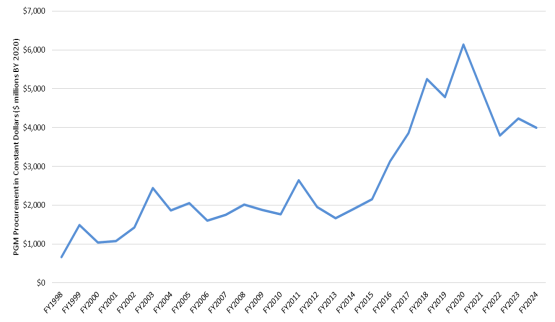 |
|
Source: Department of Defense Budget FY2000-2020 P-1 Procurement budget requests, at https://comptroller.defense.gov/Budget-Materials/, Department of Defense National Defense Budget Estimate for FY2020 pp. 58-59, at https://comptroller.defense.gov/Portals/45/Documents/defbudget/fy2020/FY20_Green_Book.pdf, Air Force FY2020 Missile procurement budget justifications; Army FY2020 Missile procurement budget justifications; Navy FY2020 Weapons procurement budget justifications. Notes: FY1998 through |
Congress, through the defense authorization and appropriations bills, has historically exercised its role in the decision to approve, reject, or modify DOD's proposals for PGMs. In addition, these programs pose a number of potential oversight issues for Congress. Congress's decisions on these issues could affect future U.S. military capabilities and funding requirements. Potential issues for Congress include
- planned procurement quantities and stockpile assessments,
- defense industrial base production capacity,
- development timelines,
- supply chain security,
- affordability and cost-effectiveness, and
- emerging factors that may affect PGM programs.
Background
DOD defines a PGM as "[a] guided weapon intended to destroy a point target and minimize collateral damage."2 In addition to these virtues, PGMs also offer other advantages over unguided weapons, namely range and the reduction in numbers of combat sorties required to deliver the desired effects on the battle field. The main disadvantage of these weapons is cost; particularly long range missiles. PGMs include air- and ship-launched missiles, multiple launched rockets, and guided bombs. Current munitions typically use a combination of radio signals from the global positioning system (GPS), laser guidance, and inertial navigation systems (INS)—using gyroscopes—to improve a weapon's accuracy to reportedly less than 3 meters (approximately 10 feet).3 PGMs have transformed attack operations from the air; instead of using hundreds of bomber sorties to attack a single target, a single sortie from a PGM-carrying platform can attack multiple targets while minimizing collateral damage.
Guided munitions were first developed in the 1940s, when the U.S Army Air Corps tested radio guidance to glide bombs onto a target.4 Prior to precision guidance, bomber missions reported an accuracy of 1,200 feet; 16% of munitions dropped by crews landed within 1,000 feet of their intended target.5 According to defense analyst Barry Watts, guidance systems showed promise in improving weapon accuracy; however, these systems were not fully fielded during the Second World War. This can partly be attributed to technological challenges in developing guidance systems, as well as relatively large unit costs per munition used. Guidance systems during this era used television signals, and required a chase aircraft to provide command and control for the weapon to strike its target.
DOD continued to develop PGMs through the 1950s and 1960s, where they gained prominence during the Vietnam War with the introduction of the laser-guided bomb. Laser-guided bombs became a preferred munition for bombing operations; an Air Force study in 1973 found that the U.S. military used more than 10,500 laser-guided bombs the previous year, with 5,107 weapons achieving a direct hit and another 4,000 achieving a circular error probable of 25 feet.6 During the 1970s and 1980s, all of the military services developed guided missiles capable of attacking fixed and moving targets. Laser-guided bombs gained prominence during Operation Desert Storm in 1991. Although PGMs represented only 6% of the total munitions used during the campaign,7 they struck a number of critical targets, reduced the number of combat sorties required, and limited collateral damage to civilian structures.8
Operations over the past decade in Afghanistan, Iraq, and Syria have demonstrated DOD's increasing reliance on PGMs and how important they have become for modern military operations. The Air Force reports that nearly 139,000 weapons have been used in combat operations in the Middle East since 2014.9 Counter-Islamic State (IS) operations in Iraq and Syria have used numerous weapons: in 2015, coalition air forces used more than 28,000 weapons; in 2016, the campaign used an additional 30,700 weapons; and in 2017 (the height of operations), the campaign used 39,500 weapons (see Figure 2 for a graphical representation of operational usage compared to DOD procurement). Nearly all of the weapons employed were PGMs, particularly Joint Direct Attack Munitions (JDAMs) and Hellfire Missiles.
|
Figure 2. PGM Operational Usage and Procurement Operational Usage in Afghanistan, Iraq, and Syria |
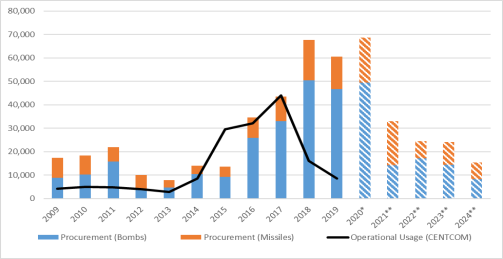 |
|
Source: Department of Defense Budget FY2000- Notes: Bomb procurement includes JDAM, Small Diameter Bomb, and Small Diameter Bomb II. Missile procurement includes Advanced Anti-Radiation Guided Missile, Army Tactical Missile System, Guided Multiple Launch Rocket System, Hellfire, Joint Air-to-Surface Strike Missile, Long Range Anti-Ship Missile, and Tomahawk. * denotes the Administration's request, ** denotes programmed funding and quantities. |
In addition to PGM use in current operations, the proliferation of anti-access/area denial (A2/AD) systems is likely to increase the operational utility of PGMs.10 Anti-access systems can be defined as capabilities "associated with denying access to major fixed-point targets, especially large forward bases."11 Area denial systems can be defined as capabilities "that threaten mobile targets over an area of operations, principally maritime forces, to include those beyond the littorals."12 Peer competitors like China and Russia have developed sophisticated air defenses, such as the S-300PMU (SA-20) and S-400 (SA-21),13 the HQ-9 surface-to-air missile (China), the DF-21D and DF-26 anti-ship ballistic missiles (China), and the 3M-54 Kaliber anti-ship cruise missile (Russia).14 Figure 3 illustrates ranges of potential A2/AD systems. These systems outrange U.S. weapons systems at what experts assess as unacceptable risk—some of these weapons have reported ranges in excess of 1,000 nautical miles.15 As a result, U.S. ships and aircraft would need to engage targets at long ranges in order to not put themselves in danger. For instance, naval ships could be threatened at ranges of 809 nautical miles from bases that field DF-21D anti-ship ballistic missiles.16
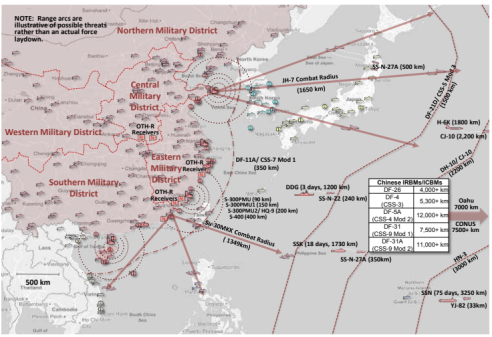 |
|
Source: Bryan Clark, Peter Haynes, and Bryan McGrath, et al., Restoring American Seapower: A New Fleet Architecture for the United States Navy, Center for Strategic and Budgetary Assessments, Washington, DC, February 9, 2017, p. 11, https://csbaonline.org/uploads/documents/CSBA6292-Fleet_Architecture_Study_REPRINT_web.pdf. Note: The figure notes state "Data to build this chart derived from OSD, Military and Security Developments Involving the People's Republic of China 2016." |
The effectiveness of these missiles is often debated, as is the amount of risk an anti-ship ballistic missile presents to naval forces. Some analysts argue that in a combat situation, aircraft carriers would not enter these weapons' engagement zones because of the threat. Others argue that while there is some risk posed to naval forces, aircraft carriers and major surface combatants would nonetheless be able to operate effectively. Similarly, an S-400 (SA-21) presents risks to aircraft at ranges of up to 215 nautical miles. Many weapons in the U.S. inventory have relatively short ranges.17 Figure 4 illustrates the impact that A2/AD systems have on potential military operations. Some analysts argue that U.S. forces would substantially increase their operational risk at ranges in excess of 500 nautical miles (NM).18
|
Figure 4. Comparison of Ranges of Military Equipment U.S. Military Aircraft vs. Adversary Drones and Missiles |
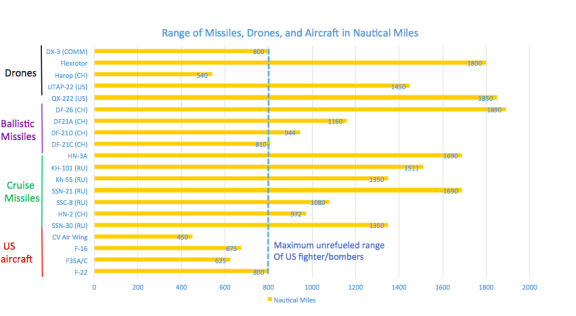 |
|
Source: https://warontherocks.com/2018/03/america-is-well-within-range-of-a-big-surprise-so-why-cant-it-see/ |
Air-Launched Precision-Guided Munitions
Paveway Laser-Guided Bombs
The Paveway is a family of guidance kits that attach to unguided bombs. The assembly includes a guidance seeker on the nose of the bomb, which looks for a laser to mark a target, and a tail kit to guide the bomb onto the target. The Paveway series was originally developed during the Vietnam War to enable tactical aircraft—like the F-4 Phantom and the A-6 Intruder—to deliver precise munitions onto a target.19 Paveway has received several upgrades, with the development of Paveway III (in the 1990s), which improves low-altitude guidance,20 and Paveway IV (in the late 1990s), which adds satellite guidance to improve accuracy.21 The U.S. military predominately uses Paveway II (see Figure 5 and Figure 6) and Paveway III kits; Paveway IV is used exclusively by foreign militaries.
According to IHS Janes, Raytheon has produced more than 350,000 Paveway kits, with Lockheed Martin producing an additional 200,000 kits.22 Funding for Paveway procurement appears in the Air Force's General Purpose Bomb line item; however, the Air Force does not report procurement quantities in its budget justification documentation.23 DOD has exported Paveway II kits to more than 30 countries, and exported Paveway III kits to at least 9 countries. Paveway IV is used by the United Kingdom, the Philippines, Saudi Arabia, and Qatar.24
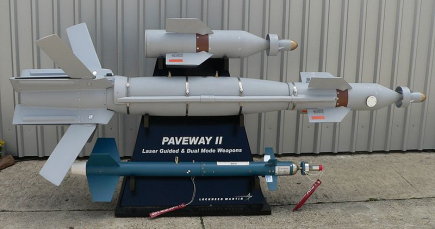 |
|
Source: https://upload.wikimedia.org/wikipedia/commons/2/2d/Paveway_II_p1230135.jpg. |
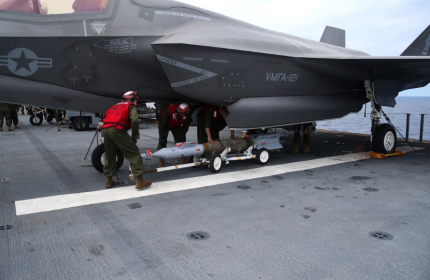 |
|
Source: https://dod.defense.gov/OIR/gallery/igphoto/2001907433/. Note: In this photo, Marines load a GBU-12 Paveway II laser-guided bomb onto an F-35B Lightning II aircraft on the flight deck of the USS Wasp during a certification exercise in the Pacific Ocean, April 18, 2018. Marine Corps photo by Cpl. Stormy Mendez. |
Joint Direct Attack Munition (JDAM)
JDAM modifies unguided bombs—such as the 5,000-pound Mk-82, the 1,000-pound Mk-83, and the 2,000-pound Mk-84—with GPS guidance. (For a fully assembled JDAM, see Figure 7; for a JDAM tail kit, see Figure 8.) When a JDAM kit is attached, the weapon is designated as GBU-31/32/38 depending on the weight of the bomb.25 These weapons have a reported range of 13 nautical miles.26 The Air Force and Navy began studying how to deliver such weapons in a program known as the Advanced Bomb Family during the 1980s.27 The first JDAMs were delivered in 1997, and underwent operational testing between 1998 and 1999.28 JDAM kits are reported to have an accuracy to within 3 meters (approximately 10 feet).29 The first operational use of a JDAM was during Operation Allied Freedom in Kosovo by a B-2 Spirit bomber. Since their development, JDAMs have been integrated with all U.S. fixed-wing strike platforms.
JDAMs have received several upgrades since their introduction into service. One of the major developments has been developing a laser guidance system in addition to receiving GPS guidance. Adding laser guidance enables JDAMs to strike both moving and fixed targets.
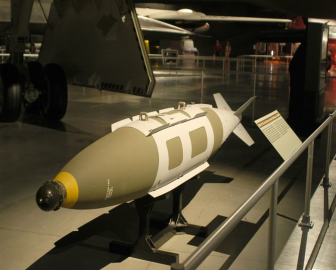 |
|
Note: The GBU-31/32 JDAM on display in the Cold War Gallery at the National Museum of the U.S. Air Force (U.S. Air Force photo). |
DOD has procured more than 371,000 JDAM kits since 1998, and it plans to procure an additional 75,000 between FY2020 and FY2024.30 According to IHS Janes, the Air Force originally projected procuring 270,000 JDAM kits. Production peaked at 30,000 kits prior to 2007 before declining until 2015. Increased operational use in Iraq and Syria, in particular, resulted in a reduction in JDAM stockpiles, leading to increased procurement from FY2016 through FY2020. Table 1 outlines the FY2020 request, along with the programmed force between FY2021 through FY2024. The DOD projects to reduce JDAM procurement in the future years defense program (FYDP); the current programmed force for FY2021 reduces procurement from more than 40,000 tailkits in FY2020 to approximately 10,000 tailkits in FY2021 and ends the FYDP with approxmately 3,700 tailkits in FY2024. In addition to U.S. military use, JDAMs have been exported to 26 countries, including Australia, Bahrain, Denmark, Finland, Israel, Italy, Japan, Kuwait, Pakistan, Saudi Arabia, Singapore, South Korea, Taiwan, Turkey, and the United Arab Emirates.31
|
FY2019 |
|
|
|
|
|
Grand Total |
|
|
Cost |
$1, |
$ |
$ |
$ |
$ |
$ |
$ |
|
Quantity |
39,688 |
40,388 |
10,209 |
12,108 |
9,246 |
3, |
115,386 |
Source: U.S. Air Force FY2020FY2021 Procurement of Ammunition Line Item 353620 Joint Direct Attack Munition, at https://apps.dtic.mil/procurement/Y2020/AirForce/stamped/U_P40_353620_BSA-13_BA-1_APP-3011F_PB_2020.pdf, and U.S. Navy FY2020, and U.S. Navy FY2021 Procurement of Ammunition Line Item 0148 JT Direct Attack Munition (JDAM), at https://apps.dtic.mil/procurement/Y2020/Navy/stamped/U_P40_0148_BSA-1_BA-1_APP-1508N_PB_2020.pdf.
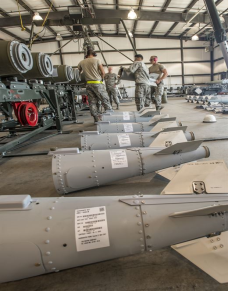 |
|
Notes: "Airmen from the 325th Maintenance Squadron, Tyndall Air Force Base, FL., lift a GBU-32 bomb tail section onto the primary bomb body at Hill AFB, UT. The bombs being assembled were later dropped by aircraft participating in exercise Combat Hammer at Hill AFB and the Utah Test and Training Range." (U.S. Air Force photo by Paul Holcomb.) |
Small Diameter Bomb (SDB) and Small Diameter Bomb II
The Small Diameter Bomb, designated as GBU-39 (Figure 9), is a 250-pound guided bomb. The SDB can use both GPS and laser guidance, enabling it to strike both fixed and moving targets.32 In 1997, responding to improvements in accuracy due to GPS, the Air Force stated a need to develop a smaller bomb to reduce collateral damage. The SDB reached initial operating capability in 2006.33 According to the Air Force, the SDB has a range of approximately 40 nautical miles.34 The SDB was specifically designed around space constraints in both the F-22 Raptor and F-35 Lightning II aircraft to enable these fighter aircraft to carry SDBs internally, while protecting their low observable signature.35
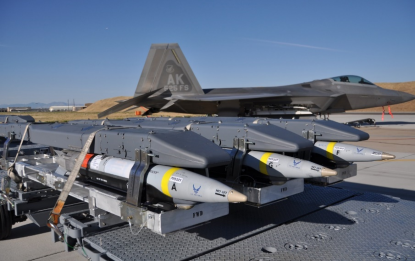 |
|
Notes: During a Combat Hammer exercise, Alaska F-22 Raptors became the first operational F-22 unit to drop GBU-39 small diameter bombs. Combat Hammer—a weapons system evaluation program sponsored by the 86th Fighter Weapons Squadron—provided an opportunity for an operational unit to employ the bombs in a realistic tactical training environment. (U.S. Air Force photo/Tech. Sgt. Dana Rosso.) |
The Air Force developed a second small diameter bomb, the GBU-53 laser-guided smaller diameter bomb, or SDB II (see Figure 10).36 The added laser guidance enables the SDB II to strike both fixed and moving targets. SDB II uses Link 16 and ultra-high frequency datalinks, along with infrared guidance, to provide course corrections.37 Development for the SDB II began in 2005, and the Air Force declared initial operating capability in 2019.38 The United States exports SDB II to Australia and South Korea as of 2019.39
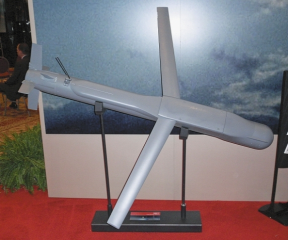 |
The Air Force procures SDBs as of 2019. From FY2005 through FY2019, the Air Force purchased more than 28,000 SDBs for more than $1.7 billion.40 Both the Air Force and the Navy requested more than 7,000 SDBs in FY2020 (the second-largest procurement on the line) for $275 million, and plan to procure an additional 8,400 SDBs from FY2021 through FY2024.41 In addition both services are procuring SDB IIs. Procurement of the SDB II began in FY2018 with 80 bombs, increasing to 1,200 bombs in FY2019. DOD requested 1,900 bombs in FY2020 for approximately $331 million, and it plans to purchase more than 10,500 SDB IIs from FY2021 through FY2024 for $1.6 billion (see Table 2).42
Table 2. Small Diameter Bomb and Small Diameter Bomb II Requested and Programmed Procurement in the FYDP
|
FY2019 |
|
|
|
|
|
Total |
|
|
SDB Cost ($ |
$ |
$ |
$45. |
$ |
$ |
$ |
$ |
|
SDB Quantity |
5,744 |
7,078 |
1, |
2,390 |
2, |
2,435 |
21,238 |
|
SDB II Cost ($ |
$ |
$ |
$ |
$ |
$ |
$ |
$2, |
|
SDB II Quantity |
1, |
1, |
2,910 |
2,718 |
2,832 |
2,065 |
13,710 |
Source: U.S. Air Force FY2020FY2021 Procurement of Missiles Line Item SDB0032SDB000 Small Diameter Bomb, U.S. Air Force FY2021 Procurement of Missiles Line Item SDB0032 Small Diameter Bomb II, and U.S. Navy FY2021 Small Diameter Bomb II, athttps://apps.dtic.mil/procurement/Y2020/AirForce/stamped/U_P40_SDB002_BSA-2_BA-2_APP-3020F_PB_2020.pdf, and U.S. Navy FY2020 Weapons Procurement Line Item 2238 Small Diameter Bomb II (SDB II), at https://apps.dtic.mil/procurement/Y2020/Navy/stamped/U_P40_2238_BSA-2_BA-2_APP-1507N_PB_2020.pdf.
AGM-114 Hellfire Missile
In the early 1970s, the Army developed a requirement for an anti-tank missile, which resulted in the AGM-114 Hellfire (see Figure 11).43 The first Hellfire was introduced into service in 1982 on the Army's AH-64 Apache, using laser guidance to target tanks, bunkers, and structures.44 Hellfire missiles have a maximum effective range of 4.3 nautical miles. By the mid-1980s, the Marine Corps had introduced Hellfire missiles to its attack helicopter fleet. Hellfire missiles have received continual upgrades over the past decades, including integrating infrared sensors, warheads to target small boats, and integration with the Apache's Longbow radar.45 During the late 1990s and early 2000s, Hellfire missiles were introduced to the MQ-1 Predator, and later to the MQ-9 Reaper, enabling unmanned aerial vehicles to provide a strike capability.46
Hellfire missiles have become a preferred munition for operations in the Middle East, particularly with increased utilization of unmanned aircraft like MQ-1s and MQ-9s. Hellfire missiles have been exported to a number of countries, including Australia, Bahrain, Egypt, India, Iraq, South Korea, Kuwait, Qatar, Saudi Arabia, Taiwan, Turkey, United Arab Emirates, and the United Kingdom.47
The Army and the Marine Corps identified the need to replace the Hellfire missile. During the mid-2000s, the two services started a new development project called the Joint Air-to-Ground Missile (JAGM), which entered testing in 2012. Both services plan to replace the Hellfire with the JAGM; however, it is unclear when they plan to make the transition.
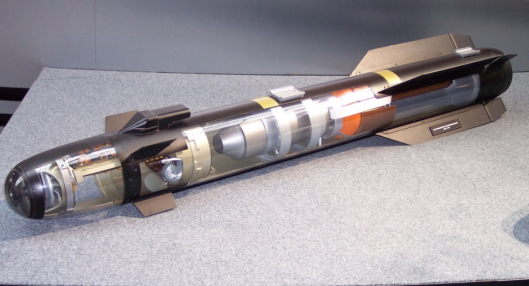 |
|
Source: https://commons.wikimedia.org/wiki/File:Lockheed_Martin_Longbow_Hellfire.jpg. Note: This image depicts an "exploded" view, depicting the internal components of the missile. |
All three military departments procure Hellfire missiles. From 1998 through 2018, DOD procured more than 71,500 missiles at a cost of $7.2 billion.48 Congress appropriated nearly $484 million for approximately 6,000 missiles in FY2019. For FY2020, DOD requested approximately $730 million for 9,000 Hellfire missiles, and it plans to purchase 13,100 missiles at a cost of $1.2 billion between FY2021 and FY2024 (Table 3).49 In its FY2020 recent budget request, DOD states that it is requesting to procure the maximum production of Hellfire missiles.50
|
FY2019 |
|
|
|
|
|
Total |
|
|
Cost ($ |
$ |
$ |
$ |
$ |
$ |
$41. |
$ |
|
Quantity |
6,066 |
9,000 |
8,391 |
2, |
2,439 |
198 |
28,214 |
Source: U.S. Army FY2020FY2021 Missiles Procurement Line Item 1338C70000 Hellfire Sys Summary, at https://apps.dtic.mil/procurement/Y2020/Army/stamped/U_P40_1338C70000_BSA-20_BA-2_APP-2032A_PB_2020.pdf; U.S. Air Force FY2020; U.S. Air Force FY2021 Missile Procurement Line Item PRDTA2 Predator Hellfire Missile, at https://apps.dtic.mil/procurement/Y2020/AirForce/stamped/U_P40_PRDTA2_BSA-2_BA-2_APP-3020F_PB_2020.pdf; and U.S. Navy FY2020; and U.S. Navy FY2021 Weapons Procurement Line Item 2254 Hellfire, at https://apps.dtic.mil/procurement/Y2020/Navy/stamped/U_P40_2254_BSA-2_BA-2_APP-1507N_PB_2020.pdf.
AGM-169 Joint Air-to-Ground Missile (JAGM)
The Joint Air-to-Ground Missile is designed to replace the Hellfire, TOW, and Maverick missiles. JAGM uses a new warhead/seeker paired with an existing AGM-114R rocket motor—which is the latest model—to provide improved target acquisition and discrimination (see Figure 12).51 The JAGM has a maximum effective range of 8.6 nautical miles when launched from a helicopter and 15.1 nautical miles when launched from fixed-wing aircraft.
JAGM underwent testing starting in 2010, and the missile entered initial operating capability in 2019, having been successfully integrated on the AH-64E Apache and AH-1Z Super Cobra attack helicopters. JAGM is expected to be integrated on other platforms as well, including the FA-18E/F Super Hornet, MQ-1C Grey Eagle, MH-60M Defensive Air Penetrator, MH-60S Seahawk, F-35 Lightning II, and P-8 Poseidon.52 In addition, the Air Force has begun procuring JAGMs but has not announced publicly what platforms will employ the missile.
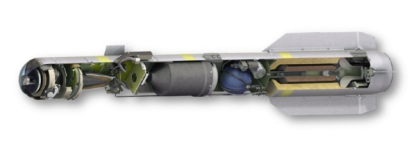 |
|
Source: https://janes.ihs.com/Janes/Display/jalw9220-jalw. Note: The JAGM's design integrates a new seeker onto the AGM-114R Hellfire II missile body (Lockheed Martin). |
JAGM entered low-rate initial production in FY2017.53 All three services are procuring JAGM, though the Air Force is requesting only 60 missiles in FY2020, with no projections of additional procurement.54 DOD requested more than $339 million and 1,000 missiles for FY2020, and it projects procuring approximately 4,600 additional missiles through FY2024 for about $1.5 billion (see Table 4).
|
FY2019 |
|
|
|
|
|
Total |
|
|
Cost |
$ |
$ |
$ |
$ |
$ |
$ |
$1, |
|
Quantity |
796 |
1,051 |
1,073 |
655 |
893 |
852 |
5,320 |
Source: U.S. Army FY2020FY2021 Missiles Procurement Line Item 2605C70302 Joint Air-to-Ground MSLS (JAGM), at https://apps.dtic.mil/procurement/Y2020/Army/stamped/U_P40_2605C70302_BSA-20_BA-2_APP-2032A_PB_2020.pdf; U.S. Air Force FY2020; U.S. Air Force FY2021 Missile Procurement Line Item JAGM00 Joint Air-to-Ground Munition, at https://apps.dtic.mil/procurement/Y2020/AirForce/stamped/U_P40_JAGM00_BSA-2_BA-2_APP-3020F_PB_2020.pdf; and U.S. Navy FY2020; and U.S. Navy FY2021 Weapons Procurement Line Item 2248 Joint Air Ground Missile (JAGM), at https://apps.dtic.mil/procurement/Y2020/Navy/stamped/U_P40_2248_BSA-2_BA-2_APP-1507N_PB_2020.pdf.
AGM-158A/B Joint Air-to-Surface Strike Missile (JASSM) and AGM-158C Long-Range Anti-Ship Missile (LRASM)
The Joint Air-to-Surface Strike Missile was conceived in the mid-1990s as a stealthy cruise missile designed to strike targets in heavily defended airspace.55 The JASSM is a 14-foot-long, 2,250-pound missile that can be carried internally on B-1B Lancer and B-52 Stratofortress aircraft and carried externally on a number of tactical fighters, including the F-16 Falcon, F-15E Strike Eagle, F/A-18 Hornet, F/A-18E/F Super Hornet, and F-35 Lightning II (see Figure 13).56 The AGM-158A JASSM has a stated range of more than 200 nautical miles.57 Initial operating capability was declared in 2005 (see Figure 14). AGM-158As have been exported to Australia, Finland, and Poland.58
In 2004, the Air Force decided that it required additional range on the JASSM and developed an extended range version, the AGM-158B JASSM-ER.59 The JASSM-ER uses the same body as the previous version with an improved infrared seeker, a two-way datalink, and enhanced anti-jam GPS receiver.60 The range of the JASSM-ER increased from more than 200 nautical miles to 500 nautical miles.61 This munition reached initial operating capability in 2014 on the B-1B Lancer. It reached full operating capability in 2018 with integration onto the F-15E Strike Eagle, and it is in full-rate production.62 The Air Force originally planned to procure 2,866 JASSMs and JASSM-ERs, but it has since changed the requirement to 7,200 missiles;63as of 2019 the Air Force has procured more than 4,000 JASSMs. Japan has expressed interest in procuring JASSM-ERs, and Poland was approved to receive 70 missiles in 2016.64
The Long Range Anti-Ship Missile (LRASM) was conceived by the Defense Advanced Research Projects Agency (DARPA) as a concept to use a JASSM body to replace the AGM-88 Harpoon.65 Flight testing for LRASM began in 2012 on board a B-1B, and the missile was tested on an F/A-18E/F Super Hornet. LRASM uses a combination of passive radio-frequency sensors, and electro-optical/infrared seekers for terminal guidance.66 Japan has expressed interest in procuring the LRASM.
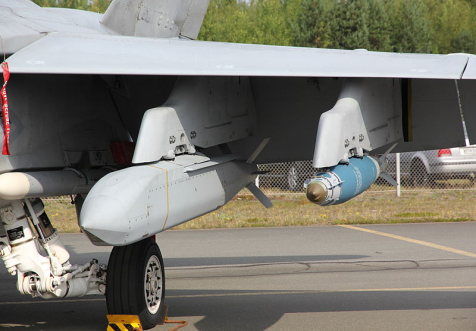 |
|
Note: JDAM precision bomb and AGM-154C Joint Standoff Weapon glide bomb under the left wing of Finnish air force F-18D Hornet fighter (HN-466) on ground display at Oulu Airport at Tour de Sky 2014 air show. |
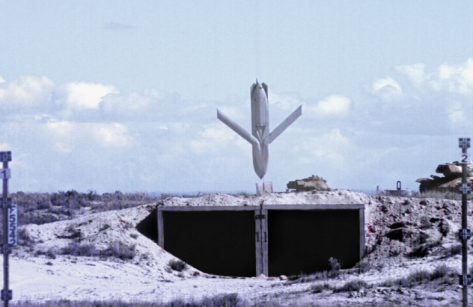 |
|
Source: https://janes.ihs.com/Janes/Display/jalw3784-jalw. Note: A JASSM hit its target during 2009 Lot 7 reliability trials (Lockheed Martin). |
The JASSM-ER and the LRASM are produced in the same facility.67 According to budget documents, DOD states that JASSM and LRASM procurement in FY2020 is at maximum production rate. The Air Force and Navy are procuring JASSM-ER and LRASM as of 2019. In FY2020, DOD requested to procure 430 JASSM-ER missiles and an additional 48 LRASMs (see Table 5). In September 2019, the Air Force announced plans to increased JASSM production to 500 missiles per year, with additional capacity to up produce 96 LRASMs.68 DOD projects reduced procurement quantities of JASSM-ER, while maintaining procurement quantities of LRASM through FY2024.
|
FY2019 |
|
|
|
|
|
Total |
|
|
JASSM Cost ($ |
$ |
$ |
$ |
$ |
$ |
$ |
$ |
|
JASSM Quantity |
360 |
430 |
297 |
265 |
273 |
263 |
1,888 |
|
LRASM Cost ($ |
$ |
$ |
$ |
$ |
$ |
$ |
$ |
|
LRASM Quantity |
50 |
48 |
48 |
48 |
48 |
48 |
290 |
Source: U.S. Air Force FY2020FY2021 Missile Procurement Line Item JASM0 Joint Air-to-Surface Standoff Missile, at https://apps.dtic.mil/procurement/Y2020/AirForce/stamped/U_P40_JASSM0_BSA-2_BA-2_APP-3020F_PB_2020.pdf; U.S. Air Force FY2020; U.S. Air Force FY2021 Missile Procurement Line Item LRASM0 LRASM0, at https://apps.dtic.mil/procurement/Y2020/AirForce/stamped/U_P40_LRASM0_BSA-2_BA-2_APP-3020F_PB_2020.pdf; and U.S. Navy FY2020; and U.S. Navy FY2021 Weapons Procurement Line Item 2291 LRASM, at https://apps.dtic.mil/procurement/Y2020/Navy/stamped/U_P40_2291_BSA-2_BA-2_APP-1507N_PB_2020.pdf.
AGM-88E Advanced Anti-Radiation Guided Missile (AARGM)
The Advanced Anti-Radiation Guided Missile is designed to target enemy integrated air defenses, specifically guidance radars (see Figure 15). AARGM was conceived in 2001 to replace the High-Speed Anti-Radiation Missile (HARM). DOD identified several deficiencies in the HARM that limited its operational effectiveness during Operation Iraqi Freedom.69 Thus, AARGM incorporated a new solid-propellant rocket motor that improved its range over the HARM, along with new guidance and seeker systems—using GPS inertial navigation for guidance and millimeter wave and W-band (higher than 40 GHz) sensors.70
AARGM entered operational testing in 2010 and initial operational capability in 2012. AARGM has been integrated on the F/A-18C/D Hornet, F/A-18E/F Super Hornet, E/A-18G Growler, F-16C/D Falcon, and the F-35 Lightning II.
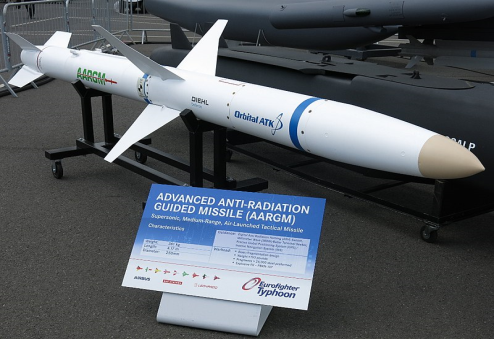 |
|
Source: https://commons.wikimedia.org/wiki/File:AGM-88E_AARGM_mockup.jpg. |
Both the Navy and the Air Force have procured the AARGM or its predecessor the HARM; however, neither service is procuring additional missiles as of FY2020.71 The Navy, however, has requested $183 million of procurement appropriations to modify its current stockpile of AARGMs. The Air Force has not requested appropriations to modify its stockpile of HARMs since FY2016.72 Table 6 describes the total DOD request for AARGM. AARGM has been exported to a number of countries, including Australia, Italy, Finland, Germany, and Poland.73
|
FY2019 |
|
|
|
|
|
Total |
|||||||||
|
Cost |
$ |
$ |
$ |
$ |
$ |
$ |
$1, AARGM Quantity — 24 32 70 109 140 375 |
Source: U.S. Navy FY2020FY2021 Weapons Procurement Line Item 2327 HARM Mods, at https://apps.dtic.mil/procurement/Y2020/Navy/stamped/U_P40_2327_BSA-3_BA-2_APP-1507N_PB_2020.pdf.
Ground-Launched Guided Munitions
Guided Multiple Launch Rocket System (GMLRS)
GMLRS (see Figure 16) is a GPS-guided 227-millimeter rocket that was jointly developed by the United States, France, Germany, Italy, and the United Kingdom.74 Development began in 1999, and the U.S. military began procuring GMLRS in FY2003. GMLRS is capable of being launched from the M270 multiple launch rocket system (MLRS) and the M142 High Mobility Artillery Rocket System (HIMARS). GMLRS has a 200-pound unitary warhead and a maximum range of 70 kilometers.75
Both the Army and the Marine Corps have procured GMLRS. Since 1998, DOD has spent nearly $5.4 billion to procure more than 42,000 rockets.76 DOD has requested more than $1.2 billion for approximately 9,900 rockets in FY2020, and it plans to spend an additional $4.3 billion for nearly 29,000 GMLRS between FY2021 and FY2024. In addition, GMLRS is being exported: Bahrain, United Arab Emirates, Poland, and Romania are procuring GMLRS, as are the development partners (France, Germany, Italy, and the United Kingdom).77 See Table 7 for an overview of the current DOD request for GMLRS.
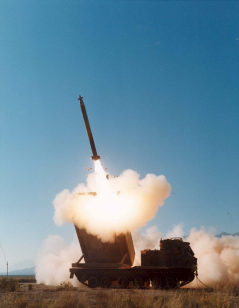 |
|
Source: https://www.lockheedmartin.com/en-us/products/guided-mlrs-unitary-rocket.html. |
|
FY2019 |
|
|
|
|
|
Total |
|
|
Cost |
$ |
$1, |
$ |
$ |
$1, |
$1, |
$6, |
|
Quantity |
7,818 |
9,910 |
10,227 |
5,051 |
7,079 |
6, |
46,648 |
Source: U.S. Army FY2020FY2021 Missile Procurement Line Item 6005C64400 Guided MLRS Rocket (GMLRS), at https://apps.dtic.mil/procurement/Y2020/Army/stamped/U_P40_6005C64400_BSA-30_BA-2_APP-2032A_PB_2020.pdf, and U.S. Navy FY2020 and U.S. Navy FY2021 Procurement, Marine Corps Line Item 3025 Guided MLRS Rocket (GMLRS), at https://apps.dtic.mil/procurement/Y2020/Navy/stamped/U_P40_3025_BSA-1_BA-3_APP-1109N_PB_2020.pdf.
Army Tactical Missile System (ATACMS)
ATACMS (see Figure 17) is a 610-millimeter rocket that can be launched from either the M270 MLRS (two rockets) or the M142 HIMARS (a single rocket). This rocket was originally developed in the 1980s and was later updated to provide GPS guidance.78 ATAMCS underwent a second upgrade in 1991, which allowed ATACMS warheads to seek and attack armored targets.79 Other upgrades have improved target discrimination and new penetrating warheads for hardened targets. In 2016, then-Secretary of Defense Ash Carter announced that the Strategic Capabilities Office had developed a new seeker that allowed the ATACMS rocket to target ships.80 The Army has stated that it intends to retire the ATACMS and replace it with the new Precision Strike Missile.
|
Figure 17. ATACMS Long-Range Precision Tactical Missile System |
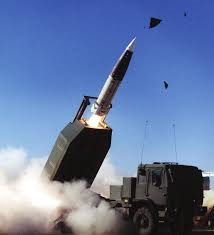 |
The Army is procuring ATACMS in FY2020, though this procurement will curtail as the Precision Strike Missile enters service. DOD requested to procure 240 missiles for $340 million in FY2020;81 it plans to procure 492 missiles for $611 million between FY2021 and FY2024. Table 8 provides an overview of the most recent request for ATACMS. Five hundred and six ATACMS have been exported to a number of countries, including the United Arab Emirates and Romania.82
|
FY2019 |
|
|
|
|
|
Total |
|
|
Cost |
$ |
$ |
$ |
$ |
$ |
$ |
$ |
|
Quantity |
— |
240 |
30 |
50 |
138 |
274 |
732 |
Source: U.S. Army FY2021 Missile Procurement Line Item 6472C98510 ARMY TACTICAL MSL SYS (ATACMS) – SYS SUS, at https://apps.dtic.mil/procurement/Y2020/Army/stamped/U_P40_6472C98510_BSA-30_BA-2_APP-2032A_PB_2020.pdf.
Precision Strike Missile (PrSM)
The PrSM is a new development program intended to replace ATACMS. PrSM is designed to be launched from the M270 and the M142 HIMARS multiple rocket launcher system. The Army states that PrSM is designed to launch two missiles in a launcher pod compared to ATACMS single missile, has a range in excess of 400 kilometers, and has an anti-jam GPS antenna.83 PrSM is in development and is planned to enter early operational service in FY2023. The Army has not stated when it intends to begin testing the PrSM. The Army states that although this missile might be sold to foreign militaries in the future, there are no purchase commitments from foreign governments as of 2019.
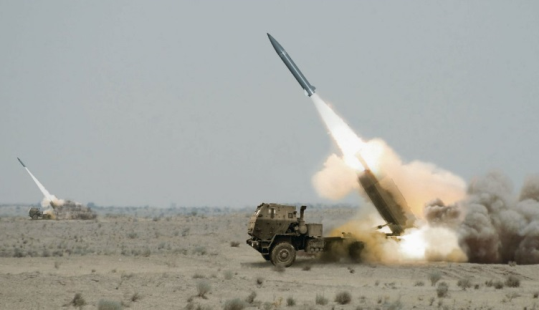 |
Table 9. PrSM Requested and Programmed Procurement
FY2020
FY2021a
FY2022b
FY2023b
FY2024b
FY2025b
Total
Cost($millions)
$49.94
$168.42
$210.06
$335.09
$309.91
$49.94
$1,073.41
Quantity
—
30
110
178
350
350
1,018
Source: U.S. Army FY2021 Missile Procurement Line Item 8540C29600 PRECISION STRIKE MISSILE (PRSM).
a. Denotes the Administration's request.
b. Denotes programmed funding and quantities.
Naval Precision-Guided Munitions
FY2020
Total
$49.94
$168.42
$210.06
$335.09
$309.91
$49.94
$1,073.41
Quantity
—
30
110
178
350
350
1,018
Source: U.S. Army FY2021 Missile Procurement Line Item 8540C29600 PRECISION STRIKE MISSILE (PRSM).
a. Denotes the Administration's request.
b. Denotes programmed funding and quantities.
Tomahawk Cruise Missile
The Tomahawk cruise missile was originally developed during the early- to mid-1970s. It was designed to be launched by submarines and from surface combatants. Designed to fly at 570 miles per hour (Mach 0.74, or 74% of the speed of sound) for up to 870 nautical miles,84 the Tomahawk has received a number of upgrades since it entered service. The Tomahawk Block IV is the current cruise missile in production and comes in two versions—one for surface ships and another for submarines (see Figure 19). Upgrades have included improvements to GPS guidance, satellite datalink communications, and propulsion.85 The first operational use of the Tomahawk was during Operation Desert Storm, where the Navy launched 290 missiles from 12 submarines. Since then, IHS Janes reports that the Navy has used more than 1,600 missiles in Iraq, Bosnia, Serbia, Afghanistan, and Syria.86 The United Kingdom is the only export customer of the Tomahawk Block IV.
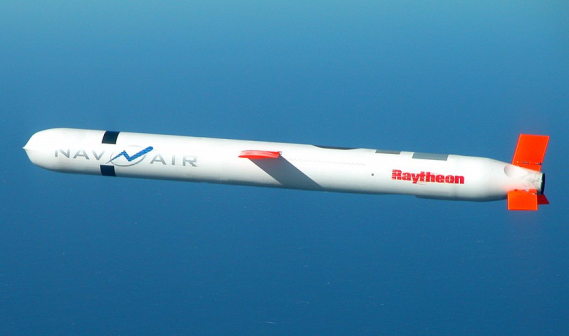 |
|
Source: https://www.navy.mil/management/photodb/photos/021110-N-0000X-003.jpg. Notes: "A Tactical 'Tomahawk' Block IV cruise missile conducts a controlled flight test over the Naval Air Systems Command western test range complex in southern California. During the second such test flight, the missile successfully completed a vertical underwater launch, flew a fully guided 780-mile course, and impacted a designated target structure as planned." (U.S. Navy photo.) |
From FY1998 through FY2018, the Navy spent $5.87 billion on 4,984 Tomahawk cruise missiles.87 The Navy has requested nearly $387 million for 90 missiles in FY2020, and it projects to procure an additional 90 missiles for nearly $374 million in FY2021, with no plans to procure additional missiles in FY2022-FY2024.88 The Navy projects requesting $819 million for additional procurement appropriations.89 (See Table 910 for the most recent Tomahawk request.)
|
FY2019 |
|
|
|
|
|
Total |
|
|
Cost |
$ |
$ |
$ |
$ |
$ |
$ |
$ |
|
Quantity |
0 |
90 |
90 |
0 |
0 |
0 |
180 |
Source: U.S. Navy FY2020FY2021 Weapons Procurement Line Item 2101 Tomahawk, at https://apps.dtic.mil/procurement/Y2020/Navy/stamped/U_P40_2101_BSA-1_BA-2_APP-1507N_PB_2020.pdf.
Standard Missile-6 (SM-6)
The Standard Missile-6 was originally designed in 2004 as an anti-aircraft missile, derived from the Navy's SM-2 Block IV (see Figure 20).90 Since its development, the SM-6 has been integrated into the Navy's Naval Integrated Fires-Counter Air (NIF-CA) program to strike enemy surface ships. The missile was designed to receive targeting information from AEGIS radars and has been upgraded to receive target information from the E-2D Advanced Hawkeye. In addition to anti-air and anti-surface missions, the SM-6 is also capable of performing anti-ballistic missile missions.91 SM-6 entered low-rate initial production in FY2009 and full rate production in FY2013.92
The SM-6 is funded under the Navy's procurement line item 2234 Standard Missile.93 According to the latest Selected Acquisition Reports, DOD increased the requirement for SM-6 missiles from 1,800 to 2,331.94 DOD requested $488 million for 125 missiles in FY2020; it is projected that DOD will procure an additional 615 missiles between FY2021 and FY2024 at a cost of nearly $2.9 billion.95 Table 1011 provides an overview of the current DOD request for SM-6 missiles.
|
FY2019 |
|
|
|
|
|
Total |
|
|
Cost ($ |
$ |
$ |
$ |
$ |
$ |
$ |
$3, |
|
Quantity |
125 |
125 |
135 |
135 |
145 |
200 |
865 |
Source: U.S Navy FY2020FY2021 Weapons Procurement Line Item 2234 Standard Missile, at https://apps.dtic.mil/procurement/Y2020/Navy/stamped/U_P40_2234_BSA-2_BA-2_APP-1507N_PB_2020.pdf.
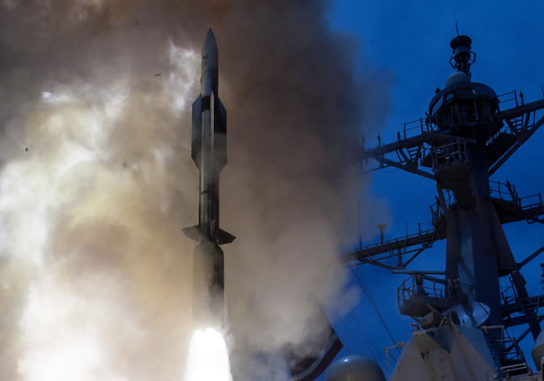 |
|
Source: https://www.raytheon.com/news/feature/sm-6_anti-surface_warfare. |
Naval Strike Missile (NSM)
The Naval Strike Missile was originally developed by the Norwegian company Kongsberg as a replacement for the Penguin anti-ship missile (see Figure 21 and Figure 22).96 This missile is an anti-ship, low-observable cruise missile capable of flying close the surface of the ocean to avoid radar detection. IHS Janes states that "[t]he NSM airframe materials and missile shape are intended to minimise its infrared (IR) and radar signatures and radar cross section."97 The NSM is designed to fly multiple flight profiles—different altitudes and speeds—with effective ranges of between 100 and 300 nautical miles at a cruise speed of up to 0.9 Mach. The Navy has integrated the NSM on its Littoral Combat Ship, which deployed into the Pacific region in September 2019.98
The Navy began procuring the NSM in FY2019 under the Littoral Combat Ship Over-the-Horizon Missile procurement line (see Table 1112). The Navy has requested $38 million for 18 missiles, and it plans to spend approximately $166 million for an additional 83 missile through FY2024. According to its budget justification, the Navy does not have a specific requirement for the number of missiles it plans to procure.99
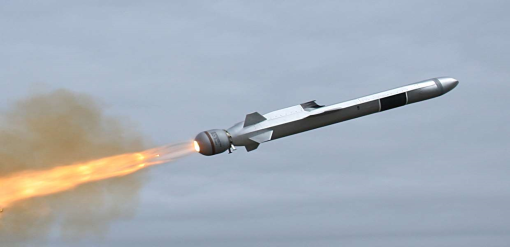 |
|
Figure 22. Illustration of Naval Strike Missile with Attributes |
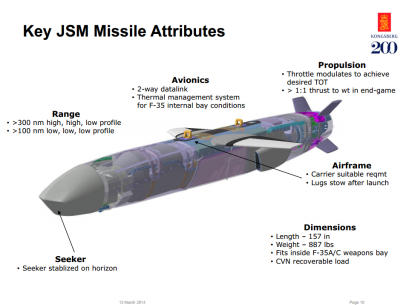 |
|
FY2019 |
|
|
|
|
|
Total |
|
|
Cost ($ |
$ |
$ |
$ |
$ |
$ |
$ |
$ |
|
Quantity |
8 |
18 |
15 |
16 |
26 |
26 |
109 |
Source: U.S. Navy FY2020FY2021 Weapons Procurement Line Item 2292 LCS OTH Missile, at https://apps.dtic.mil/procurement/Y2020/Navy/stamped/U_P40_2292_BSA-2_BA-2_APP-1507N_PB_2020.pdf.
Potential Issues for Congress
- Planned procurement quantities and stockpile assessment. One potential issue for Congress is whether DOD's desired quantities of standoff munitions are appropriate. Current operations have demonstrated a large demand for all types of PGMs. A potential high-intensity conflict would potentially require large stockpiles of all types of weapons.100 Several of these types of munitions—particularly JASSM, LRASM, and AARGM—are being procured in relatively small quantities, given their potential use rates in a high-intensity conflict scenario, along with the time it would take for replacement spent munitions once initial inventories are exhausted. A related issue is whether DOD has adequately assessed the sufficiency of existing and planned PGM stockpiles, particularly in light of recent use rates for such weapons. Congress has from time to time required DOD to assess munitions requirements, as well as to report on combatant command munitions requirements. More recently, Congress required DOD to provide an annual report on the munitions inventory, along with an unconstrained assessment of munitions requirements.101
- Defense industrial base production capacity. Another potential issue for Congress concerns the defense industrial base's capacity for building PGMs, particularly for meeting increased demands for such weapons during an extended-duration, high-intensity conflict. The question is part of a larger issue of whether various parts of the U.S. defense industrial base are adequate, in an era of renewed great power competition, to meet potential wartime mobilization demands.102
- Supply chain security. Another potential issue for Congress concerns supply chain security, meaning whether U.S. PGMs incorporate components, materials, or software of foreign origin. Supply chain security could affect wartime reliability of these weapons as well as the ability of the U.S. industrial base to build replacement PGMs in a timely manner during an extended-duration, high-intensity conflict.
- Development timelines. Congress may be concerned about the development timeline of PGMs compared with development timelines of adversary A2/AD capabilities. China and Russia have developed sophisticated systems over the past 10 years, while DOD has developed relatively few systems. Some analysts argue that these systems can exceed DOD munitions capabilities (such as range and speed).103 Can and, if so, should DOD develop new systems and at a pace that can match or exceed that of Chinese or Russian weapons systems?
- Affordability and cost-effectiveness. Congress may also be concerned about the affordability of DOD's plans for procuring various PGMs in large numbers, and the cost-effectiveness of PGMs relative to other potential means of accomplishing certain DOD missions, particularly in a context of finite DOD resources and competing DOD program priorities. Another aspect of cost-effectiveness concerns the cost of the weapon compared to the cost of a target. For instance, in 2017 a U.S. ally used a $3 million Patriot missile to engage a $300 quadcopter drone.104
- Emerging factors that may affect PGM programs. Another potential issue for Congress is how DOD's programs for developing and procuring PGMs might be affected by emerging factors such as
- the U.S. withdrawal from the Intermediate Nuclear Force (INF) treaty;105
- new U.S. military operational concepts for countering Chinese A2/AD forces in the Indo-Pacific region, such as the Army's new Multi-Domain Operations (MDO) operational concept and the Marine Corps' new Expeditionary Advanced Base Operations (EABO) concept, both of which possibly feature the potential use of such weapons from island locations in the Pacific as a way of countering China's A2/AD forces; and
- emerging technologies such as hypersonics and artificial intelligence (AI).106
Appendix A. Prior Year Procurement by Service
|
Service |
FY1998 |
FY1999 |
FY2000 |
FY2001 |
FY2002 |
FY2003 |
FY2004 |
FY2005 |
FY2006 |
FY2007 |
FY2008 |
FY2009 |
|
|
Army |
Nominal Cost ($m) |
$330.40 |
$398.90 |
$384.70 |
$377.80 |
$273.30 |
$449.20 |
$189.30 |
$377.80 |
$304.70 |
$201.30 |
$601.08 |
$562.33 |
|
Constant Cost ($m FY2020) |
$489.34 |
$582.93 |
$554.16 |
$535.58 |
$380.80 |
$612.57 |
$251.80 |
$490.33 |
$386.28 |
$250.22 |
$735.72 |
$678.65 |
|
|
Quantity |
1,209 |
2,096 |
2,310 |
2,300 |
2,224 |
978 |
846 |
1,110 |
1,082 |
943 |
5,004 |
5,597 |
|
|
Air Force |
Nominal Cost ($m) |
$ |
$79.50 |
$189.20 |
$203.70 |
$343.70 |
$543.70 |
$540.00 |
$717.00 |
$413.40 |
$609.40 |
$438.81 |
$551.44 |
|
Constant Cost ($m FY2020) |
$71.98 |
$116.18 |
$272.54 |
$288.77 |
$478.89 |
$741.44 |
$718.28 |
$930.56 |
$524.09 |
$757.49 |
$537.09 |
$665.51 |
|
|
Quantity |
1,655 |
3,778 |
8,436 |
8,904 |
14,468 |
23,577 |
20,584 |
23,633 |
9,248 |
11,301 |
6,588 |
10,048 |
|
|
Navy |
Nominal Cost ($m) |
$ |
$538.60 |
$148.20 |
$182.10 |
$405.40 |
$798.80 |
$674.20 |
$491.10 |
$547.70 |
$600.70 |
$606.56 |
$447.86 |
|
Constant Cost ($m FY2020) |
$105.45 |
$787.08 |
$213.48 |
$258.15 |
$564.86 |
$1,089.32 |
$896.78 |
$637.38 |
$694.35 |
$746.67 |
$742.42 |
$540.50 |
|
|
Quantity |
547 |
1,475 |
2,153 |
2,625 |
14,608 |
12,750 |
12,893 |
7,928 |
4,830 |
4,790 |
2,899 |
1,752 |
Source: Department of Defense Budget FY2000-2020 P-1 Procurement budget requests, at https://comptroller.defense.gov/Budget-Materials/, Department of Defense National Defense Budget Estimate for FY2020 pp. 58-59, at https://comptroller.defense.gov/Portals/45/Documents/defbudget/fy2020/FY20_Green_Book.pdf, Air Force FY2020 Missile procurement budget justifications; Army FY2020 Missile procurement budget justifications; Navy FY2020 Weapons procurement budget justifications.
|
Service |
FY2010 |
FY2011 |
FY2012 |
FY2013 |
FY2014 |
FY2015 |
FY2016 |
FY2017 |
FY2018 |
FY2019 |
FY2020* |
Total |
|
|
Army |
Nominal Cost ($m) |
$580.41 |
$ |
$442.13 |
$240.23 |
$382.52 |
$ |
$ |
$ |
$1,639.33 |
$1,425.64 |
$2,232.32 |
$13,377.47 |
|
Constant Cost ($m FY2020) |
$689.49 |
$ |
$508.90 |
$272.68 |
$428.06 |
$ |
$ |
$1,028.14 |
$1,705.51 |
$1,454.14 |
$2,232.32 |
$15,412.24 |
|
|
Quantity |
5,393 |
4,065 |
4,101 |
1,741 |
2,511 |
1,030 |
2,249 |
8,211 |
12,660 |
10,848 |
15,531 |
94,039 |
|
|
Air Force |
Nominal Cost ($m) |
$471.19 |
$ |
$484.97 |
$433.86 |
$587.13 |
$ |
$1,792.59 |
$1,611.86 |
$2,243.54 |
$2,178.85 |
$2,372.15 |
$18,571.71 |
|
Constant Cost ($m FY2020) |
$559.74 |
$ |
$558.21 |
$492.47 |
$657.04 |
$1,067.50 |
$1,941.08 |
$1,711.11 |
$2,334.11 |
$2,222.41 |
$2,372.15 |
$20,893.44 |
|
|
Quantity |
11,386 |
16,955 |
5,440 |
5,194 |
11,226 |
12,612 |
32,568 |
35,701 |
48,111 |
46,363 |
49,602 |
417,378 |
|
|
Navy |
Nominal Cost ($m) |
$435.01 |
$1,022.50 |
$767.75 |
$796.26 |
$729.05 |
$ |
$ |
$1,053.63 |
$1,167.53 |
$1,084.67 |
$1,541.60 |
$15,679.18 |
|
Constant Cost ($m FY2020) |
$516.77 |
$1,194.93 |
$883.69 |
$903.81 |
$815.86 |
$ |
$ |
$1,118.51 |
$1,214.66 |
$1,106.35 |
$1,541.60 |
$18,287.35 |
|
|
Quantity |
1,573 |
1,087 |
783 |
1,184 |
497 |
343 |
250 |
534 |
8,217 |
4,696 |
5,152 |
93,566 |
Source: Department of Defense Budget FY2000-2020 P-1 Procurement budget requests, at https://comptroller.defense.gov/Budget-Materials/, Department of Defense National Defense Budget Estimate for FY2020 pp. 58-59, at https://comptroller.defense.gov/Portals/45/Documents/defbudget/fy2020/FY20_Green_Book.pdf, Air Force FY2020 Missile procurement budget justifications; Army FY2020 Missile procurement budget justifications; Navy FY2020 Weapons procurement budget justifications.
Appendix B. Prior Year Procurement by Program
|
Program |
FY1998 |
FY1999 |
FY2000 |
FY2001 |
FY2002 |
FY2003 |
FY2004 |
FY2005 |
FY2006 |
FY2007 |
FY2008 |
FY2009 |
|
|
ARRGM |
Nominal Cost ($m) |
$- |
$ |
$ |
$89.10 |
$4.90 |
$3.90 |
$ |
$ |
$ |
$ |
$ |
$41.02 |
|
Constant Cost ($m FY2020) |
$- |
$ |
$ |
$126.31 |
$6.83 |
$5.32 |
$ |
$ |
$ |
$ |
$ |
$49.51 |
|
|
Quantity |
- |
- |
- |
270 |
- |
- |
- |
- |
- |
- |
- |
- |
|
|
ATACMS |
Nominal Cost ($m) |
$ |
$90.60 |
$90.80 |
$95.10 |
$35.00 |
$ |
$57.60 |
$160.80 |
$104.10 |
$76.30 |
$84.78 |
$ |
|
Constant Cost ($m FY2020) |
$ |
$132.40 |
$130.80 |
$134.82 |
$48.77 |
$ |
$76.62 |
$208.70 |
$131.97 |
$94.84 |
$103.77 |
$ |
|
|
Quantity |
109 |
96 |
110 |
100 |
24 |
156 |
60 |
156 |
98 |
18 |
84 |
- |
|
|
GMLRS |
Nominal Cost ($m) |
$- |
$ |
$ |
$ |
$ |
$ |
$106.80 |
$111.30 |
$121.60 |
$125.00 |
$263.71 |
$309.21 |
|
Constant Cost ($m FY2020) |
$- |
$ |
$ |
$ |
$ |
$ |
$142.06 |
$144.45 |
$154.16 |
$155.38 |
$322.78 |
$373.17 |
|
|
Quantity |
- |
- |
- |
- |
- |
822 |
786 |
954 |
984 |
925 |
2,070 |
2,652 |
|
|
Hellfire |
Nominal Cost ($m) |
$ |
$308.30 |
$313.80 |
$282.70 |
$238.30 |
$ |
$46.10 |
$202.80 |
$210.10 |
$244.50 |
$387.89 |
$483.52 |
|
Constant Cost ($m FY2020) |
$ |
$450.53 |
$452.03 |
$400.77 |
$332.03 |
$ |
$61.32 |
$263.21 |
$266.35 |
$303.92 |
$474.78 |
$583.54 |
|
|
Quantity |
1,100 |
2,000 |
2,425 |
2,200 |
2,200 |
137 |
172 |
1,020 |
1,423 |
2,958 |
4,611 |
5,584 |
|
|
JAGM |
Nominal Cost ($m) |
$- |
$ |
$ |
$ |
$ |
$ |
$ |
$ |
$ |
$ |
$ |
$ |
|
Constant Cost ($m FY2020) |
$- |
$ |
$ |
$ |
$ |
$ |
$ |
$ |
$ |
$ |
$ |
$ |
|
|
Quantity |
- |
- |
- |
- |
- |
- |
- |
- |
- |
- |
- |
- |
|
|
JASSM |
Nominal Cost ($m) |
$- |
$ |
$ |
$0.20 |
$42.70 |
$53.80 |
$100.90 |
$139.20 |
$98.70 |
$156.50 |
$160.04 |
$139.70 |
|
Constant Cost ($m FY2020) |
$- |
$ |
$ |
$0.28 |
$59.50 |
$73.37 |
$134.21 |
$180.66 |
$125.13 |
$194.53 |
$195.88 |
$168.60 |
|
|
Quantity |
- |
- |
- |
- |
76 |
100 |
240 |
288 |
75 |
163 |
111 |
100 |
|
|
JDAM |
Nominal Cost ($m) |
$ |
$117.30 |
$270.40 |
$272.70 |
$602.80 |
$ |
$689.40 |
$665.50 |
$306.10 |
$280.70 |
$167.10 |
$175.09 |
|
Constant Cost ($m FY2020) |
$ |
$171.42 |
$389.51 |
$386.59 |
$839.91 |
$1,025.91 |
$917.00 |
$863.72 |
$388.06 |
$348.91 |
$204.53 |
$211.30 |
|
|
Quantity |
2,202 |
4,523 |
10,300 |
11,229 |
28,945 |
35,620 |
32,666 |
29,756 |
11,605 |
10,585 |
5,724 |
6,242 |
|
|
LRASM |
Nominal Cost ($m) |
$- |
$ |
$ |
$ |
$ |
$ |
$ |
$ |
$ |
$ |
$ |
$ |
|
Constant Cost ($m FY2020) |
$- |
$ |
$ |
$ |
$ |
$ |
$ |
$ |
$ |
$ |
$ |
$ |
|
|
Quantity |
- |
- |
- |
- |
- |
- |
- |
- |
- |
- |
- |
- |
|
|
SDB |
Nominal Cost ($m) |
$- |
$ |
$ |
$ |
$ |
$ |
$ |
$29.10 |
$52.20 |
$114.70 |
$94.65 |
$132.82 |
|
Constant Cost ($m FY2020) |
$- |
$ |
$ |
$ |
$ |
$ |
$ |
$37.77 |
$66.18 |
$142.57 |
$115.85 |
$160.29 |
|
|
Quantity |
- |
- |
- |
- |
- |
- |
- |
199 |
567 |
2,030 |
1,395 |
2,612 |
|
|
SDB II |
Nominal Cost ($m) |
$- |
$ |
$ |
$ |
$ |
$ |
$ |
$ |
$ |
$ |
$ |
$ |
|
Constant Cost ($m FY2020) |
$- |
$ |
$ |
$ |
$ |
$ |
$ |
$ |
$ |
$ |
$ |
$ |
|
|
Quantity |
- |
- |
- |
- |
- |
- |
- |
- |
- |
- |
- |
- |
|
|
SM-6 |
Nominal Cost ($m) |
$- |
$ |
$ |
$ |
$ |
$ |
$ |
$ |
$ |
$ |
$ |
$ |
|
Constant Cost ($m FY2020) |
$- |
$ |
$ |
$ |
$ |
$ |
$ |
$ |
$ |
$ |
$ |
$ |
|
|
Quantity |
- |
- |
- |
- |
- |
- |
- |
- |
- |
- |
- |
- |
|
|
Tomahawk |
Nominal Cost ($m) |
$ |
$439.20 |
$ |
$ |
$73.00 |
$ |
$352.00 |
$277.20 |
$373.00 |
$353.00 |
$475.83 |
$280.27 |
|
Constant Cost ($m FY2020) |
$ |
$641.82 |
$ |
$ |
$101.71 |
$ |
$468.21 |
$359.77 |
$472.87 |
$438.78 |
$582.41 |
$338.24 |
|
|
Quantity |
- |
624 |
- |
- |
25 |
350 |
322 |
298 |
408 |
355 |
496 |
207 |
Source: Department of Defense Budget FY2000-2020 P-1 Procurement budget requests, at https://comptroller.defense.gov/Budget-Materials/, Department of Defense National Defense Budget Estimate for FY2020 pp. 58-59, at https://comptroller.defense.gov/Portals/45/Documents/defbudget/fy2020/FY20_Green_Book.pdf, Air Force FY2020 Missile procurement budget justifications; Army FY2020 Missile procurement budget justifications; Navy FY2020 Weapons procurement budget justifications.
|
Program |
FY2010 |
FY2011 |
FY2012 |
FY2013 |
FY2014 |
FY2015 |
FY2016 |
FY2017 |
FY2018 |
FY2019 |
FY2020* |
Grand Total |
|
|
ARRGM |
Nominal Cost ($m) |
$47.83 |
$51.91 |
$76.56 |
$83.89 |
$94.06 |
$ |
$ |
$ |
$ |
$ |
$ |
$1,447.49 |
|
Constant Cost ($m FY2020) |
$56.81 |
$60.66 |
$88.12 |
$95.22 |
$105.26 |
$ |
$ |
$ |
$ |
$ |
$ |
$1,591.34 |
|
|
Quantity |
33 |
44 |
72 |
- |
- |
- |
- |
- |
- |
- |
- |
419 |
|
|
ATACMS |
Nominal Cost ($m) |
$ |
$ |
$ |
$ |
$35.60 |
$ |
$ |
$ |
$ |
$1,398.59 |
||
|
Constant Cost ($m FY2020) |
$ |
$ |
$ |
$ |
$39.84 |
$ |
$ |
$ |
$ |
$ |
$ |
$1,763.63 |
|
|
Quantity |
- |
- |
- |
- |
24 |
- |
- |
- |
240 |
1,275 |
|||
|
GMLRS |
Nominal Cost ($m) |
$353.31 |
$ |
$333.17 |
$214.29 |
$273.03 |
$ |
$ |
$ |
$1,027.97 |
$ |
$1,274.79 |
$6,671.77 |
|
Constant Cost ($m FY2020) |
$419.71 |
$ |
$383.48 |
$243.23 |
$305.53 |
$ |
$ |
$ |
$1,069.46 |
$ |
$1,274.79 |
$7,316.34 |
|
|
Quantity |
3,228 |
2,592 |
3,194 |
1,608 |
2,166 |
768 |
1,866 |
3,360 |
6,528 |
7,818 |
9,910 |
52,231 |
|
|
Hellfire |
Nominal Cost ($m) |
$422.45 |
$ |
$221.42 |
$146.08 |
$166.17 |
$ |
$ |
$ |
$ |
$ |
$ |
$8,463.01 |
|
Constant Cost ($m FY2020) |
$501.84 |
$ |
$254.86 |
$165.81 |
$185.95 |
$ |
$ |
$ |
$ |
$ |
$ |
$9,944.97 |
|
|
Quantity |
4,684 |
2,970 |
2,162 |
1,315 |
1,143 |
3,405 |
6,639 |
6,797 |
10,501 |
6,066 |
9,000 |
80,512 |
|
|
JAGM |
Nominal Cost ($m) |
$ |
$ |
$ |
$ |
$ |
$ |
$27.74 |
$83.83 |
$ |
$ |
$ |
$913.68 |
|
Constant Cost ($m FY2020) |
$ |
$ |
$ |
$ |
$ |
$ |
$30.04 |
$88.99 |
$ |
$ |
$ |
$934.11 |
|
|
Quantity |
- |
- |
- |
- |
- |
- |
- |
469 |
899 |
796 |
1,051 |
3,215 |
|
|
JASSM |
Nominal Cost ($m) |
$52.52 |
$ |
$236.19 |
$230.19 |
$271.15 |
$ |
$ |
$ |
$ |
$ |
$ |
$4,575.77 |
|
Constant Cost ($m FY2020) |
$62.38 |
$ |
$271.86 |
$261.28 |
$303.44 |
$ |
$ |
$ |
$ |
$ |
$ |
$5,078.47 |
|
|
Quantity |
- |
171 |
202 |
233 |
187 |
240 |
340 |
360 |
360 |
360 |
430 |
4,036 |
|
|
JDAM |
Nominal Cost ($m) |
$192.32 |
$ |
$127.25 |
$144.61 |
$250.47 |
$ |
$ |
$ |
$1,149.39 |
$1,010.55 |
$1,148.90 |
$10,178.07 |
|
Constant Cost ($m FY2020) |
$228.46 |
$ |
$146.47 |
$164.14 |
$280.29 |
$ |
$ |
$ |
$1,195.78 |
$1,030.75 |
$1,148.90 |
$11,995.77 |
|
|
Quantity |
7,517 |
13,061 |
4,259 |
4,678 |
10,415 |
8,786 |
22,478 |
28,596 |
42,864 |
39,688 |
40,388 |
412,127 |
|
|
LRASM |
Nominal Cost ($m) |
$ |
$ |
$ |
$ |
$ |
$ |
$ |
$ |
$ |
$ |
$ |
$603.99 |
|
Constant Cost ($m FY2020) |
$ |
$ |
$ |
$ |
$ |
$ |
$ |
$ |
$ |
$ |
$ |
$621.88 |
|
|
Quantity |
- |
- |
- |
- |
- |
- |
- |
36 |
50 |
50 |
48 |
184 |
|
|
SDB |
Nominal Cost ($m) |
$141.69 |
$ |
$20.14 |
$1.97 |
$ |
$51.30 |
$ |
$ |
$ |
$ |
$ |
$2,013.32 |
|
Constant Cost ($m FY2020) |
$168.32 |
$ |
$23.18 |
$2.24 |
$ |
$56.54 |
$ |
$ |
$ |
$ |
$ |
$2,214.16 |
|
|
Quantity |
2,694 |
2,785 |
150 |
- |
- |
443 |
3,494 |
4,507 |
7,471 |
5,744 |
7,078 |
41,169 |
|
|
SDB II |
Nominal Cost ($m) |
$ |
$ |
$ |
$ |
$ |
$ |
$ |
$ |
$20.97 |
$ |
$ |
$544.00 |
|
Constant Cost ($m FY2020) |
$ |
$ |
$ |
$ |
$ |
$ |
$ |
$ |
$21.81 |
$ |
$ |
$548.69 |
|
|
Quantity |
- |
- |
- |
- |
- |
- |
- |
- |
90 |
1,260 |
1,925 |
3,275 |
|
|
SM-6 |
Nominal Cost ($m) |
$ |
$ |
$356.88 |
$332.54 |
$300.19 |
$ |
$ |
$ |
$ |
$ |
$ |
$4,018.96 |
|
Constant Cost ($m FY2020) |
$ |
$ |
$410.77 |
$377.45 |
$335.93 |
$ |
$ |
$ |
$ |
$ |
$ |
$4,330.87 |
|
|
Quantity |
- |
67 |
89 |
89 |
93 |
100 |
101 |
125 |
125 |
125 |
125 |
1,039 |
|
|
Tomahawk |
Nominal Cost ($m) |
$276.50 |
$ |
$297.61 |
$293.58 |
$307.46 |
$ |
$ |
$ |
$ |
$98.57 |
$ |
$6,348.64 |
|
Constant Cost ($m FY2020) |
$328.46 |
$ |
$342.55 |
$333.24 |
$344.06 |
$ |
$ |
$ |
$ |
$ |
$ |
$7,651.42 |
|
|
Quantity |
196 |
417 |
196 |
196 |
206 |
243 |
149 |
196 |
100 |
- |
90 |
5,074 |
Source: Department of Defense Budget FY2000-2020 P-1 Procurement budget requests, at https://comptroller.defense.gov/Budget-Materials/, Department of Defense National Defense Budget Estimate for FY2020 pp. 58-59, at https://comptroller.defense.gov/Portals/45/Documents/defbudget/fy2020/FY20_Green_Book.pdf, Air Force FY2020 Missile procurement budget justifications; Army FY2020 Missile procurement budget justifications; Navy FY2020 Weapons procurement budget justifications.
Author Contact Information
Footnotes
| 1. |
Air Force FY2020 Missile Procurement budget justifications; Army FY2020 Missile Procurement budget justifications; Navy FY2020 Weapons Procurement budget justifications. |
| 2. |
Department of Defense, DOD Dictionary of Military and Associated Terms, July 2019, at https://www.jcs.mil/Portals/36/Documents/Doctrine/pubs/dictionary.pdf/. |
| 3. |
IHS Janes, "GBU-39/B Small Diameter Bomb (SDB I), GBU-39B/B Laser SDB (LSDB)," June 7, 2019, at https://janes.ihs.com/Janes/Display/jalw9077-jalw. |
| 4. |
Barry D. Watts, Six Decades of Guided Munitions and Battle Networks: Progress and Prospects, Center for Strategic and Budgetary Assessments, Washington, DC, March 2007, at https://csbaonline.org/uploads/documents/2007.03.01-Six-Decades-Of-Guided-Weapons.pdf. |
| 5. |
John T. Correll, "Daylight Precision Bombing," Air Force Magazine, October 2008, at http://www.airforcemag.com/MagazineArchive/Pages/2008/October%202008/1008daylight.aspx. |
| 6. |
Circular error probable is the metric used to identify how accurate a specific munition is. This metric measures the distance 50% of a type of weapon will land from the aim point. Barry D. Watts, Six Decades of Guided Munitions and Battle Networks: Progress and Prospects, Center for Strategic and Budgetary Assessments, Washington, DC, March 2007, pp. 9-10, at https://csbaonline.org/uploads/documents/2007.03.01-Six-Decades-Of-Guided-Weapons.pdf. |
| 7. |
During Operation Desert Storm, the stockpile of laser guided bombs was limited due to cost. A single Paveway bomb tail kit in 1991 cost approximately $20,000, a reduction from $40,000 in 1998. See Malcolm W. Browne, "Invention That Shaped the Gulf War: the Laser-Guided Bomb," New York Times, February 26, 1991, pp. C-1, at https://www.nytimes.com/1991/02/26/science/invention-that-shaped-the-gulf-war-the-laser-guided-bomb.html. |
| 8. |
Eliot Cohen, Tom Keaney, et al., Gulf War Air Power Study Volume IV: Weapons, Tactics, and Training and Space Operations, U.S. Air Force, Washington, DC, 1993, https://media.defense.gov/2010/Sep/27/2001329817/-1/-1/0/AFD-100927-066.pdf. |
| 9. |
Air Force Central reports the number of U.S. and coalition weapons used in Afghanistan, Iraq, and Syria. Air Force Central, "Airpower Summaries," press release, September 1, 2019, https://www.afcent.af.mil/About/Airpower-Summaries/. |
| 10. |
Jan van Tol, Mark Gunzinger, Andrew Krepinevich, et al., AirSea Battle: A Point-of-Departure Operational Concept, Center for Strategic and Budgetary Assessments, Washington, DC, May 2010, https://csbaonline.org/uploads/documents/2010.05.18-AirSea-Battle.pdf. |
| 11. |
Jan Van Tol et al., AirSea Battle: A Point-of-Departure Operational Concept, Center for Strategic and Budgetary Assessments, Washington, DC, May 18, 2010, p. 1, https://csbaonline.org/uploads/documents/2010.05.18-AirSea-Battle.pdf. |
| 12. |
Jan Van Tol et al., AirSea Battle: A Point-of-Departure Operational Concept, Center for Strategic and Budgetary Assessments, Washington, DC, May 18, 2010, p. 1, https://csbaonline.org/uploads/documents/2010.05.18-AirSea-Battle.pdf. |
| 13. |
According to IHS Janes, the S-400 has a maximum range of 400 kilometers. IHS Janes "S-400," October 7, 2019, at https://janes.ihs.com/Janes/Display/jlad0593-jaad. |
| 14. |
According to IHS Janes, the DF-21D has a range of 1,500 kilometers, and the DF-26 has a range of approximately 4,000 kilometers. See IHS Janes "DF-21," February 21, 2019, at https://janes.ihs.com/Janes/Display/jsws0411-jsws, and IHS Janes "DF-26," February 1, 2019, at https://janes.ihs.com/Janes/Display/jswsa399-jsws. |
| 15. |
Jan van Tol, Mark Gunzinger, Andrew Krepinevich, et al., AirSea Battle: A Point-of-Departure Operational Concept, Center for Strategic and Budgetary Assessments, Washington, DC, May 2010, https://csbaonline.org/uploads/documents/2010.05.18-AirSea-Battle.pdf. |
| 16. |
See IHS Janes "DF-21," February 21, 2019, at https://janes.ihs.com/Janes/Display/jsws0411-jsws. |
| 17. |
Guided bombs have a maximum range of 40 nautical miles; longer-range missiles typically have a range around 150-500 nautical miles. |
| 18. |
Jan van Tol, Mark Gunzinger, Andrew Krepinevich, et al., AirSea Battle: A Point-of-Departure Operational Concept, Center for Strategic and Budgetary Assessments, Washington, DC, May 2010, https://csbaonline.org/uploads/documents/2010.05.18-AirSea-Battle.pdf. |
| 19. |
IHS Janes "GBU-10/12/16/58 Paveway II," October 17, 2018, at https://janes.ihs.com/Janes/Display/jalwa051-jalw. |
| 20. |
IHS Janes "GBU-22, GBU-24, GBU-27 Paveway III, and Enhanced Paveway III," September 10, 2019, at https://janes.ihs.com/Janes/Display/jalw3671-jalw. |
| 21. |
IHS Janes "Paveway IV (PGB)," February 13, 2019, at https://janes.ihs.com/Janes/Display/jalw9213-jalw. |
| 22. |
IHS Janes "GBU-10/12/16/58 Paveway II," October 17, 2018, at https://janes.ihs.com/Janes/Display/jalwa051-jalw. |
| 23. |
U.S. Air Force FY2020 Procurement of Ammunition Line Item 353020 General Purpose Bombs, at https://apps.dtic.mil/procurement/Y2020/AirForce/stamped/U_P40_353020_BSA-13_BA-1_APP-3011F_PB_2020.pdf. |
| 24. |
IHS Janes "Paveway IV (PGB)," February 13, 2019, at https://janes.ihs.com/Janes/Display/jalw9213-jalw. |
| 25. |
U.S. Air Force, "Joint Direct Attack Munition GBU-31/32/38 Fact Sheet," press release, June 18, 2003, https://www.af.mil/About-Us/Fact-Sheets/Display/Article/104572/joint-direct-attack-munition-gbu-313238/. |
| 26. |
IHS Janes "GBU-31/32/38 Joint Direct Attack Munition (JDAM)," June 18, 2019, at https://janes.ihs.com/Janes/Display/jalw3667-jalw. |
| 27. |
IHS Janes "GBU-31/32/38 Joint Direct Attack Munition (JDAM)," June 18, 2019, at https://janes.ihs.com/Janes/Display/jalw3667-jalw. |
| 28. |
According to the Air Force, approximately 450 JDAMs were dropped during the operational testing phase. See U.S. Air Force, "Joint Direct Attack Munition GBU-31/32/38 Fact Sheet," press release, June 18, 2003, https://www.af.mil/About-Us/Fact-Sheets/Display/Article/104572/joint-direct-attack-munition-gbu-313238/. |
| 29. |
IHS Janes "GBU-31/32/38 Joint Direct Attack Munition (JDAM)," June 18, 2019, at https://janes.ihs.com/Janes/Display/jalw3667-jalw. |
| 30. |
See Department of Defense Budget FY2000-2020 P-1 Procurement budget requests, at https://comptroller.defense.gov/Budget-Materials/. |
| 31. |
IHS Janes "GBU-31/32/38 Joint Direct Attack Munition (JDAM)," June 18, 2019, at https://janes.ihs.com/Janes/Display/jalw3667-jalw. |
| 32. |
U.S. Air Force, "GBU-39B Small Diameter Bomb Weapon System Fact Sheet," press release, August 28, 2006, https://www.af.mil/About-Us/Fact-Sheets/Display/Article/104573/gbu-39b-small-diameter-bomb-weapon-system/. |
| 33. |
U.S. Air Force, "GBU-39B Small Diameter Bomb Weapon System Fact Sheet," press release, August 28, 2006, https://www.af.mil/About-Us/Fact-Sheets/Display/Article/104573/gbu-39b-small-diameter-bomb-weapon-system/. |
| 34. |
U.S. Air Force, "GBU-39B Small Diameter Bomb Weapon System Fact Sheet," press release, August 28, 2006, https://www.af.mil/About-Us/Fact-Sheets/Display/Article/104573/gbu-39b-small-diameter-bomb-weapon-system/. |
| 35. |
IHS Janes "GBU-39/B Small Diameter Bomb (SDB I), GBU-39B/B Laser SDB (LSDB), June 7, 2019, at https://janes.ihs.com/Janes/Display/jalw9077-jalw. |
| 36. |
The SDB II is a separate procurement line item in both budget justifications and in Congressional authorization and appropriations. |
| 37. |
IHS Janes "StormBreaker bomb (GBU-53/B SDB II)," July 8, 2019, at https://janes.ihs.com/Janes/Display/jalwa099-jalw. |
| 38. |
IHS Janes "StormBreaker bomb (GBU-53/B SDB II)," July 8, 2019, at https://janes.ihs.com/Janes/Display/jalwa099-jalw. |
| 39. |
IHS Janes "StormBreaker bomb (GBU-53/B SDB II)," July 8, 2019, at https://janes.ihs.com/Janes/Display/jalwa099-jalw. |
| 40. |
See Department of Defense Budget FY2000-2020 P-1 Procurement budget requests, at https://comptroller.defense.gov/Budget-Materials/. |
| 41. |
U.S. Air Force FY2020 Procurement of Missiles Line Item SDB000 Small Diameter, at https://apps.dtic.mil/procurement/Y2020/AirForce/stamped/U_P40_SDB000_BSA-2_BA-2_APP-3020F_PB_2020.pdf. |
| 42. |
U.S. Air Force FY2020 Procurement of Missiles Line Item SDB0032 Small Diameter Bomb II, athttps://apps.dtic.mil/procurement/Y2020/AirForce/stamped/U_P40_SDB002_BSA-2_BA-2_APP-3020F_PB_2020.pdf, and U.S. Navy FY2020 Weapons Procurement Line Item 2238 Small Diameter Bomb II (SDB II), at https://apps.dtic.mil/procurement/Y2020/Navy/stamped/U_P40_2238_BSA-2_BA-2_APP-1507N_PB_2020.pdf. |
| 43. |
IHS Janes "AGM-114 Hellfire and Longbow Hellfire," June 21, 2019, at https://janes.ihs.com/Janes/Display/jalw3064-jalw. |
| 44. |
IHS Janes "AGM-114 Hellfire and Longbow Hellfire," June 21, 2019, at https://janes.ihs.com/Janes/Display/jalw3064-jalw. |
| 45. |
IHS Janes "AGM-114 Hellfire and Longbow Hellfire," June 21, 2019, at https://janes.ihs.com/Janes/Display/jalw3064-jalw. |
| 46. |
U.S. Air Force, "MQ-1B Predator Fact Sheet," September 23, 2015, at https://www.af.mil/About-Us/Fact-Sheets/Display/Article/104469/mq-1b-predator/. |
| 47. |
IHS Janes "AGM-114 Hellfire and Longbow Hellfire," June 21, 2019, at https://janes.ihs.com/Janes/Display/jalw3064-jalw. |
| 48. |
See Department of Defense Budget FY2000-2020 P-1 Procurement budget requests, at https://comptroller.defense.gov/Budget-Materials/. |
| 49. |
U.S. Army FY2020 Missiles Procurement Line Item 1338C70000 Hellfire Sys Summary, at https://apps.dtic.mil/procurement/Y2020/Army/stamped/U_P40_1338C70000_BSA-20_BA-2_APP-2032A_PB_2020.pdf, U.S. Air Force FY2020 Missile Procurement Line Item PRDTA2 Predator Hellfire Missile, at https://apps.dtic.mil/procurement/Y2020/AirForce/stamped/U_P40_PRDTA2_BSA-2_BA-2_APP-3020F_PB_2020.pdf, and U.S. Navy FY2020 Weapons Procurement Line Item 2254 Hellfire, at https://apps.dtic.mil/procurement/Y2020/Navy/stamped/U_P40_2254_BSA-2_BA-2_APP-1507N_PB_2020.pdf. |
| 50. |
Department of Defense, "FY2020 Program Acquisition Costs by Weapons System," at https://comptroller.defense.gov/Portals/45/Documents/defbudget/fy2020/fy2020_Weapons.pdf. |
| 51. |
IHS Janes "Joint Air-to-Ground Missile (JAGM)," April 11, 2019, at https://janes.ihs.com/Janes/Display/jalw9220-jalw. |
| 52. |
IHS Janes "Joint Air-to-Ground Missile (JAGM)," April 11, 2019, at https://janes.ihs.com/Janes/Display/jalw9220-jalw. |
| 53. |
IHS Janes "Joint Air-to-Ground Missile (JAGM)," April 11, 2019, at https://janes.ihs.com/Janes/Display/jalw9220-jalw. |
| 54. |
U.S. Air Force FY2020 Missile Procurement Line Item JAGM00 Joint Air-to-Ground Munition, at https://apps.dtic.mil/procurement/Y2020/AirForce/stamped/U_P40_JAGM00_BSA-2_BA-2_APP-3020F_PB_2020.pdf. |
| 55. |
U.S. Air Force, "JASSM - The Air Force's Next Generation Cruise Missile," press release, March 6, 2008, https://www.afmc.af.mil/News/Article-Display/Article/155587/jassm-the-air-forces-next-generation-cruise-missile/. |
| 56. |
IHS Janes "AGM-158A JASSM and AGM-158B JASSM-ER," July 23, 2019, at https://janes.ihs.com/Janes/Display/jalw3784-jalw. |
| 57. |
U.S. Air Force, "JASSM - The Air Force's Next Generation Cruise Missile," press release, March 6, 2008, https://www.afmc.af.mil/News/Article-Display/Article/155587/jassm-the-air-forces-next-generation-cruise-missile/. |
| 58. |
IHS Janes "AGM-158A JASSM and AGM-158B JASSM-ER," July 23, 2019, at https://janes.ihs.com/Janes/Display/jalw3784-jalw. |
| 59. |
IHS Janes "AGM-158A JASSM and AGM-158B JASSM-ER," July 23, 2019, at https://janes.ihs.com/Janes/Display/jalw3784-jalw. |
| 60. |
IHS Janes "AGM-158A JASSM and AGM-158B JASSM-ER," July 23, 2019, at https://janes.ihs.com/Janes/Display/jalw3784-jalw. |
| 61. |
U.S. Air Force, "JASSM - The Air Force's Next Generation Cruise Missile," press release, March 6, 2008, https://www.afmc.af.mil/News/Article-Display/Article/155587/jassm-the-air-forces-next-generation-cruise-missile/. |
| 62. |
IHS Janes "AGM-158A JASSM and AGM-158B JASSM-ER," July 23, 2019, at https://janes.ihs.com/Janes/Display/jalw3784-jalw. |
| 63. |
Department of Defense, "Comprehensive Selected Acquisition Reports for the Annual 2018 Reporting Requirements as Updated by the President's Fiscal Year 2020 Budget," press release, August 1, 2019, https://media.defense.gov/2019/Aug/01/2002165676/-1/-1/1/DEPARTMENT-OF-DEFENSE-SELECTED-ACQUISITION-REPORTS-(SARS)-DECEMBER-2018.PDF. |
| 64. |
IHS Janes "AGM-158A JASSM and AGM-158B JASSM-ER," July 23, 2019, at https://janes.ihs.com/Janes/Display/jalw3784-jalw. |
| 65. |
IHS Janes "AGM-158C Long-Range Anti-Ship Missile (LRASM)," July 8, 2019, at https://janes.ihs.com/Janes/Display/jalwa137-jalw. |
| 66. |
IHS Janes "AGM-158C Long-Range Anti-Ship Missile (LRASM)," July 8, 2019, at https://janes.ihs.com/Janes/Display/jalwa137-jalw. |
| 67. |
Department of Defense, "FY2020 Program Acquisition Costs by Weapons System," at https://comptroller.defense.gov/Portals/45/Documents/defbudget/fy2020/fy2020_Weapons.pdf. |
| 68. |
Sara Sirota, "Air Force reveals plans to grow stockpile of JASSM, LRASM missiles," Inside Defense, September 27, 2019, at https://insidedefense.com/daily-news/air-force-reveals-plans-grow-stockpile-jassm-lrasm-missiles. |
| 69. |
IHS Janes "AGM-88E Advanced Anti-Radiation Guided Missile (AARGM)," July 31, 2019, at https://janes.ihs.com/Janes/Display/jalw3723-jalw. |
| 70. |
IHS Janes "AGM-88E Advanced Anti-Radiation Guided Missile (AARGM)," July 31, 2019, at https://janes.ihs.com/Janes/Display/jalw3723-jalw. |
| 71. |
Department of Defense, Program Acquisition Cost by Weapon System, Washington, DC, March 2019, p. 5-3, https://comptroller.defense.gov/Portals/45/Documents/defbudget/fy2020/fy2020_Weapons.pdf. |
| 72. |
See Department of Defense Budget FY2018 P-1 Procurement budget requests, at https://comptroller.defense.gov/Budget-Materials/. |
| 73. |
IHS Janes "AGM-88E Advanced Anti-Radiation Guided Missile (AARGM)," July 31, 2019, at https://janes.ihs.com/Janes/Display/jalw3723-jalw. |
| 74. |
IHS Janes "227 mm MLRS/GMLRS rockets," April 3, 2019, at https://janes.ihs.com/Janes/Display/jah_1074-jah_. |
| 75. |
IHS Janes "227 mm MLRS/GMLRS rockets," April 3, 2019, at https://janes.ihs.com/Janes/Display/jah_1074-jah_. |
| 76. |
See Department of Defense Budget FY2000-2020 P-1 Procurement budget requests, at https://comptroller.defense.gov/Budget-Materials/. |
| 77. |
IHS Janes "227 mm MLRS/GMLRS rockets," April 3, 2019, at https://janes.ihs.com/Janes/Display/jah_1074-jah_. |
| 78. |
IHS Janes "610 mm Army Tactical Missile System rockets," June 28, 2019, at https://janes.ihs.com/Janes/Display/jah_1090-jah_. |
| 79. |
IHS Janes "610 mm Army Tactical Missile System rockets," June 28, 2019, at https://janes.ihs.com/Janes/Display/jah_1090-jah_. |
| 80. |
Sydney J. Freedberg Jr., "Carter, Roper Unveil Army's New Ship-Killer Missile: ATACMS Upgrade," Breaking Defense, October 28, 2016, at https://breakingdefense.com/2016/10/army-atacms-missile-will-kill-ships-secdef-carter/. |
| 81. |
U.S. Army Missile Procurement Line Item 6472C98510 ARMY TACTICAL MSL SYS (ATACMS) – SYS SUS, at https://apps.dtic.mil/procurement/Y2020/Army/stamped/U_P40_6472C98510_BSA-30_BA-2_APP-2032A_PB_2020.pdf |
| 82. |
IHS Janes "610 mm Army Tactical Missile System rockets," June 28, 2019, at https://janes.ihs.com/Janes/Display/jah_1090-jah_. |
| 83. |
U.S. Army Acquisition Support Center "Precision Strike Missile Fact Sheet," at https://asc.army.mil/web/portfolio-item/ms-prsm/. |
| 84. |
IHS Janes "Tomahawk/RGM/UGM-109A/B/C/D/E," September 2, 2019, at https://janes.ihs.com/Janes/Display/jnws0162-jnw_. |
| 85. |
IHS Janes "Tomahawk/RGM/UGM-109A/B/C/D/E," September 2, 2019, at https://janes.ihs.com/Janes/Display/jnws0162-jnw_. |
| 86. |
IHS Janes "Tomahawk/RGM/UGM-109A/B/C/D/E," September 2, 2019, at https://janes.ihs.com/Janes/Display/jnws0162-jnw_. |
| 87. |
See Department of Defense Budget FY2000-2020 P-1 Procurement budget requests, at https://comptroller.defense.gov/Budget-Materials/. |
| 88. |
U.S. Navy FY2020 Weapons Procurement Line Item 2101 Tomahawk, at https://apps.dtic.mil/procurement/Y2020/Navy/stamped/U_P40_2101_BSA-1_BA-2_APP-1507N_PB_2020.pdf. |
| 89. |
U.S. Navy FY2020 Weapons Procurement Line Item 2101 Tomahawk, at https://apps.dtic.mil/procurement/Y2020/Navy/stamped/U_P40_2101_BSA-1_BA-2_APP-1507N_PB_2020.pdf. |
| 90. |
IHS Janes "Stand Missile-6 (SM-6)/Extended Range Active Missile ERAM)," April 3, 2019, at https://janes.ihs.com/Janes/Display/jnw_0076-jnw_. |
| 91. |
Raytheon, "One missile, many missions: SM-6 Missile Gives Surface Forces More Power in More Places," press release, January 9, 2019, https://www.raytheon.com/news/feature/sm-6_anti-surface_warfare. |
| 92. |
U.S. Navy FY2014 Weapons Procurement Line Item 2234 Standard Missile, at https://apps.dtic.mil/procurement/Y2014/Navy/stamped/P40_2234_BSA-2_BA-2_APP-1507N_PB_2014.pdf. |
| 93. |
U.S Navy FY2020 Weapons Procurement Line Item 2234 Standard Missile, at https://apps.dtic.mil/procurement/Y2020/Navy/stamped/U_P40_2234_BSA-2_BA-2_APP-1507N_PB_2020.pdf. |
| 94. |
Department of Defense, "Comprehensive Selected Acquisition Reports for the Annual 2018 Reporting Requirements as Updated by the President's Fiscal Year 2020 Budget," press release, August 1, 2019, https://media.defense.gov/2019/Aug/01/2002165676/-1/-1/1/DEPARTMENT-OF-DEFENSE-SELECTED-ACQUISITION-REPORTS-(SARS)-DECEMBER-2018.PDF. |
| 95. |
U.S Navy FY2020 Weapons Procurement Line Item 2234 Standard Missile, at https://apps.dtic.mil/procurement/Y2020/Navy/stamped/U_P40_2234_BSA-2_BA-2_APP-1507N_PB_2020.pdf. |
| 96. |
IHS Janes "Naval Strike Missile (NSM)," May, 21, 2019, at https://janes.ihs.com/Janes/Display/jnws0911-jnw_. |
| 97. |
IHS Janes "Naval Strike Missile (NSM)," May, 21, 2019, at https://janes.ihs.com/Janes/Display/jnws0911-jnw_. |
| 98. |
David B. Larter, "US Navy deploys new ship-killer missile to China's backyard," Defense News, September 5, 2019, at https://www.defensenews.com/naval/2019/09/06/the-us-navy-just-deployed-its-new-ship-killer-missile-to-chinas-backyard/. |
| 99. |
U.S. Navy FY2020 Weapons Procurement Line Item 2292 LCS OTH Missile, at https://apps.dtic.mil/procurement/Y2020/Navy/stamped/U_P40_2292_BSA-2_BA-2_APP-1507N_PB_2020.pdf. |
| 100. |
Gary Roughead, Eric Edelman, et al., Providing for the Common Defense, National Defense Strategy Commission, The Assessment and Recommendations of the National Defense Strategy Commission, 2018, https://www.usip.org/sites/default/files/2018-11/providing-for-the-common-defense.pdf. |
| 101. |
See P.L. 115-232 §1061 and §1067. |
| 102. |
For more information, see CRS Report R43838, Renewed Great Power Competition: Implications for Defense—Issues for Congress, by Ronald O'Rourke. |
| 103. |
Gary Roughead, Eric Edelman, et al., Providing for the Common Defense, National Defense Strategy Commission, The Assessment and Recommendations of the National Defense Strategy Commission, 2018, https://www.usip.org/sites/default/files/2018-11/providing-for-the-common-defense.pdf. |
| 104. |
Chris Baraniuk, "Small drone 'shot with Patriot missile,'" BBC, March 15, 2017, at https://www.bbc.com/news/technology-39277940. |
| 105. |
For more information on the INF treaty and its implications for U.S. policy, see CRS Report R43832, Russian Compliance with the Intermediate Range Nuclear Forces (INF) Treaty: Background and Issues for Congress, by Amy F. Woolf. |
| 106. |
For more information on each of these technologies, see CRS Report R45811, Hypersonic Weapons: Background and Issues for Congress, by Kelley M. Sayler, and CRS Report R45178, Artificial Intelligence and National Security, by Kelley M. Sayler. |